 Herbert Kastle writes South Beach as Sodom in his sprawling kidnap thriller. 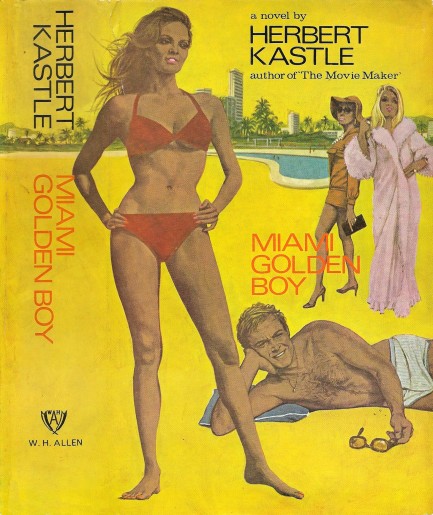
Miami Golden Boy is the wrong title for this book. It's too trite for the tale of a plot to kidnap the invalid former president of the U.S., which intersects a plot by Havana expats to return to Cuba and depose Fidel Castro. While the book gets its name from the ostensible central figure Bruce Golden, there's a vast assortment of characters, including a Kennedyesque political clan, that keeps him out of the narrative for entire chapters. These characters have deeply detailed personal lives that add dimension but strain credulity. One secretly has cancer, one is secretly gay, one is secretly sadistic, one is secretly a pedophile, one is being blackmailed, one is secretly a drug addict, one is secretly suicidal. It's a lot. But okay, the only question that matters is does it all work? Well, mostly. Kastle uses these secrets to weave a tale of decadent American decline, with South Beach as a backdrop. A choice example:
“The country is beginning to stink. Our stated goals and our actual goals are drawing farther and farther apart. And the divergence is tearing us apart. We've either got to bring the actual goals closer to the stated goals—reduce the materialism in our lives, the idiocy of our anti-communist crusades, the cruelty and blindness of our dealings with blacks—or admit that the stated goals are false.”
Kastle wrote that fifty-two years ago, and we know how things have gone since then. His abduction plot is a symptom of the greed, hypocrisy, and decline he details. The scheme involves several characters using several other characters as pawns. The lever in most cases is sex, and the book is pretty well packed with sexual content, occasionally explicit, and in one case violent. Then there's that pedo thing too. Kastle doesn't shy away from it, though you may wish he had. The tapestry of duplicity and manipulation, in terms of how it relates to the kidnap, needs to weave together in perfect synchronization, and of course doesn't. The scheme blows up spectacularly. If it didn't there'd be no book. Conversely, Kastle brings everyone's secret stories to miraculous conclusions within the space of the final thirty pages. That's the drawback of so many characters—a few story arcs don't end convincingly.
Even so, the one thing you cannot say is that Kastle doesn't know how to write. His skillful prose makes the slam bang climax almost believable. Bruce Golden, a bit of a shallow playboy, isn't a great guy but at least he isn't a killer, kidnapper, or political plotter, so he's the character you root for. His love interest Ellie De Wyant, on the other hand, is a crucial if unwitting cog in the kidnapping, which means if Golden is to have her he may have to do something he's never done in his entire life—show courage in the face of danger. Will he or won't he? We think Miami Golden Boy is worth a read to find the answer. And speaking of worth, books with Barbara Walton cover art aren't usually cheap, but this one from the publisher W.H. Allen was. We got lucky. Walton was one of the top illustrators of her era. See more from her here and here.
 Thanks for rescuing me. Don't untie me yet, though. First let me tell you about this kinky fantasy I've always had. 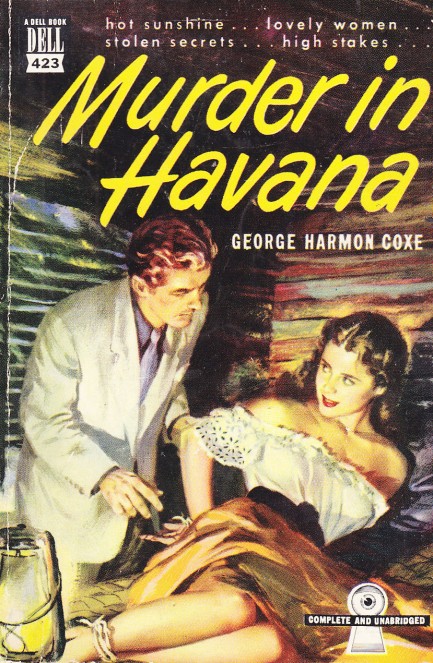
George Harmon Coxe's Murder in Havana was an easy buy for us—it was cheap and set in an exotic land. We were also drawn by its World War II backdrop, which made us fully expect Nazis, and we got them. The story concerns Andrew Talbot, who's in charge of a secret shipbuilding project. While he's out on the town someone breaks into his hotel room but somehow ends up dead five floors below. Talbot is relieved not to have been robbed of his top secret dox, but once he realizes the dead man hadn't been the only person in his room and his papers were photographed rather than stolen, he sets out to save his professional reputation and unmask the spies. As required from this sort of tale, the hero meets a couple of beautiful women, interfaces fractiously with the local cops, gets knocked over the head, and drinks rum. Mysteries from this era can be wordy, but Coxe deserves credit—he keeps the action moving around Havana and avoids the pointless reiterations that can slow these books. The ending is fun, and multi-layered. There could be more local color and travelogue, and we aren't sure if we accept the idea of skeleton keys being purchaseable on the street, but overall Murder in Havana is quite entertaining. It was published in 1943 originally, with this Dell edition and its Barye Phillips cover art of a woman bound but incongruously smiling coming in 1950.
 Mystery attackers of U.S. embassy workers in Havana might not be Cuban—or human. 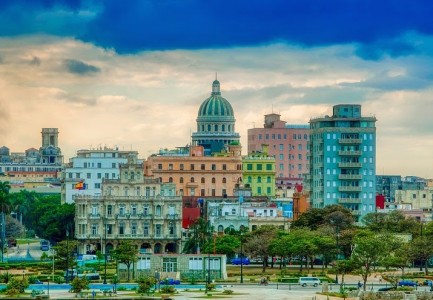
A couple of nights ago PSGP and PI-1 were in deep slumber in their seaside apartment when a high pitched noise sprang up in the wee hours. It took only moments to identify the sound as a cricket, which somehow had gained entry to their bedroom though it's on the top floor three stories up, and the exterior doors were shut. What followed was a comedy of errors, as PSGP tried in vain to pinpoint the noise and eject the interloper, while PI-1 cursed all of creation because insects were now conspiring to disturb her sleep. They ended up moving out of the bedroom. The next day PSGP had another look around, and after a more careful examination located the cricket—outside on the balcony. It had never gained entry to the flat in the first place. It was just that loud and disorienting. This is an absolutely true story, and even the timeline is factual. It really did happen night before last.
So imagine our surprise when an item came across the wires this morning about the infamous Havana Syndrome. You know the one. U.S. embassy personnel stationed in Cuba, beginning in 2016, reported mysterious sounds in the building, which brought on headaches, dizziness, tinnitus, balance problems, and other weird effects. The State Department and the American press immediately ran a political football the entire length of the unverified news field and claimed Cuban or Russian sonic or energy weapons were probably the cause. Nobody explained what Cuba or Russia had to gain from quasi-effectual sonic attacks, and it didn't matter, because you never let implausibility get in the way of rekindling the Cold War. But there are these people called scientists, and they have a way of studying things until they find answers, and yesterday the most likely cause of the dastardly Havana Syndrome was revealed to be crickets.
The JASON Group, an independent organization of scientists that works with the U.S. government, analyzed recordings made by embassy personnel and found only one phenomenon to be a sonic match—the Indies short-tailed cricket. There the sneaky bugger is just below. This mystery was actually unravelled back in 2019, but the report was classified—probably to milk a few more years from a patently ridiculous story of being targeted by commies. Let's face it—when you have top level Cuban figures defensively trying to explain that they have no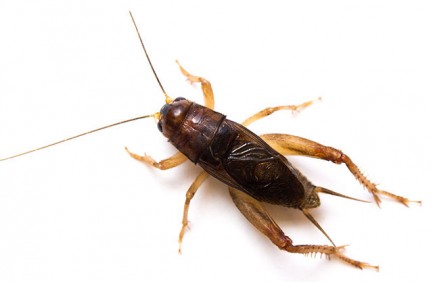 sonic or energy weapons, and the American press is pretty much dismissing those claims, you keep the pressure on. Some experts note that sonic weapon frequencies wouldn't be recordable, and the enemy attack theory is thus unaffected. In other words, the recordings given to JASON scientists weren't of the actual phenomenon in question. Well, okay, but we prefer crickets. Please let it be crickets. Or maybe the answer is twofold. Maybe Havana Syndrome is caused by crickets trained by Cuba or Russia. Bet those egghead scientists didn't even think of that. sonic or energy weapons, and the American press is pretty much dismissing those claims, you keep the pressure on. Some experts note that sonic weapon frequencies wouldn't be recordable, and the enemy attack theory is thus unaffected. In other words, the recordings given to JASON scientists weren't of the actual phenomenon in question. Well, okay, but we prefer crickets. Please let it be crickets. Or maybe the answer is twofold. Maybe Havana Syndrome is caused by crickets trained by Cuba or Russia. Bet those egghead scientists didn't even think of that.
 Whether by day or night the action was non-stop. 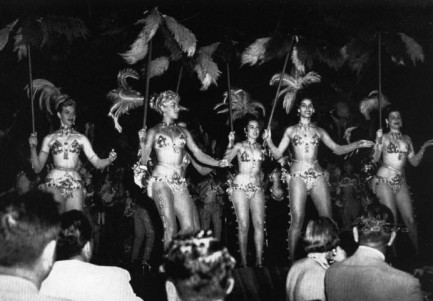
We love vintage nightclub photos, and vintage pix of people partying in general. Since Havana photos are unusually interesting, we're always drawn to them. There's a large number of Havana photos out there, but not primarily because of Cuba's political history. The photos really exist because Cuba was a pioneer of Caribbean tourism, attracting travelers beginning in the 1920s through a heyday of the mid-1950s. The island was promoted as a place of sophistication, mixed with permissiveness, unpredictability, and a touch of the primitive. This prompted various movers and shakers—from New York City businessmen to top musicians to Hollywood stars—to flock to Havana. And where important people went, cameras followed.
Was the Havana image true? Probably, based on what we've read. But it was not unique. During the same period Tangier had a similar reputation, as it attracted writers like Paul Bowles, William S. Burroughs, and numerous gay expatriates. During the 1960s Acapulco was known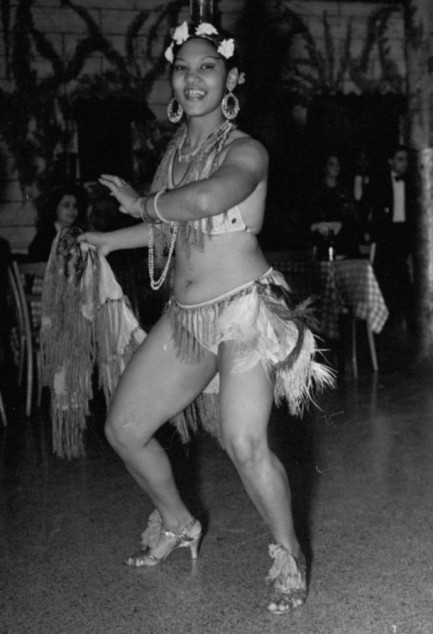 as a great place to go for thrills. During the 1980s, Ibiza or Mykonos. The 90s, Thailand or Goa. The 00s, Tulum. Havana wasn't unusual in terms of what it offered. Bigger, yes. More convenient for Americans, for sure. But numerous far flung locales have served as paradises for foreign visitors to lose themselves and get crazy. as a great place to go for thrills. During the 1980s, Ibiza or Mykonos. The 90s, Thailand or Goa. The 00s, Tulum. Havana wasn't unusual in terms of what it offered. Bigger, yes. More convenient for Americans, for sure. But numerous far flung locales have served as paradises for foreign visitors to lose themselves and get crazy.
Most or all of the aforementioned places are considered to have changed for the worse, whether through ecological damage, destruction of historic architecture, unchecked overbuilding, overtourism, or all four scourges at once. But it was revolution that changed Havana, a fact that gives vintage photos from there a particular poignancy. A typical narrative is that while elites and tourists partied, exclusion, inequality, and poverty helped fertilize the seeds of upheaval. But we don't judge anyone in these shots. We've lived in similar circumstances in Central America. We were even partners in a beach bar in the Caribbean. We were always well aware of the prevailing socio-political problems, and we sympathized greatly with the local populations. But it didn't stop us from partying the nights away.
There's an immense feeling of freedom being in a simpler place—and for all its opulent nightclubs and restaurants, Havana is said to have exuded a primeval sensuality that intoxicated tourists and expatriates. If you live in the U.S. or some other modern nation, that feeling isn't something you can achieve by merely paring down your current lifestyle. The things you give up continue to exist all around you. By rejecting those, you become a weirdo. But by living in a less modern nation your life truly changes top to bottom, and you gain this while still existing above the local mean. That's the paradox, or the injustice, depending on your point of view: your satisfaction derives partly from the ability to take or leave anything you wish, because you are economically able to do so. You live more simply than you did, yet live better than most people around you. It isn't noble, but it's very much an attraction.
Bowles and Burroughs lived well in Tangier because it was immensely cheaper than Europe or the U.S. With the savings gained they hosted parties and had time to hone their literary crafts. They were a part of the local society, but existed in a middle-upper stratum, high above the impoverished, well below the Moroccan elites, benefitting from the general perception that foreigners from rich nations are themselves rich. That's how it was for us too. So there's inequality built into that type of expatriate experience. It's unavoidable. A friend of ours lived in a stick shack on Cayos Cochinos for an entire year and he was still considered a rich foreigner. Everyone knows you have a choice. The Americans who partied in Cuba could never have been anything but wealthy invaders, no matter the reality of their finances, or the inclusiveness their sensibilities. type of expatriate experience. It's unavoidable. A friend of ours lived in a stick shack on Cayos Cochinos for an entire year and he was still considered a rich foreigner. Everyone knows you have a choice. The Americans who partied in Cuba could never have been anything but wealthy invaders, no matter the reality of their finances, or the inclusiveness their sensibilities.
Living comfortably means the novelties one experiences seem thrilling or romantic. When we were knocking around Guatemala, El Salvador, and the Bay Islands, we turned washing our clothes by hand into an enjoyable ritual, yet understood quite well that many families' daily water intake literally depended on walking a mile to a river. Buying food from the local fruit and veggie stand was far more convenient than queuing at the supermarket for meat, and we ended up dropping to our college weight, but we were nevertheless aware that many people couldn't afford any food, and would have been disgusted at how pleased we were that our reduced fat intake meant we could show six pack abs at the beach. We helped some local families, both financially and logistically, but when your downsized existence is a choice you can never truly fit in.
But the freedom you feel is real. Offloading the burdens of modern life brings legitimate satisfaction. The pursuit of pleasure takes on a special joy. We hit bars, parties, and gallery mixers continually. As foreigners there's no social stigma to drinking every night. Unless you have a job—and we didn't—it's how you form a social circle. Locals generally disapprove, but their judgements carry little weight. So when we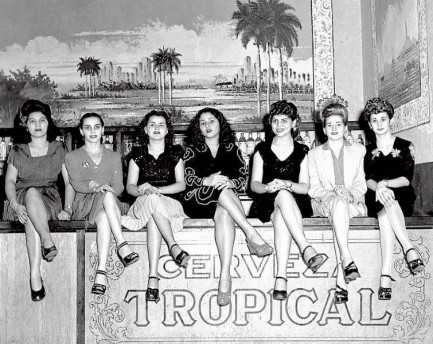 look at Havana partying shots we don't quite see oblivious, entitled people, because we know it isn't that simple. Most of them knew what was percolating. Stability was diminishing fast. There was a dissolved parliament, large protests, a 1953 battle in Santiago de Cuba, and other signposts on the way to change. It was clear the fun could never last. look at Havana partying shots we don't quite see oblivious, entitled people, because we know it isn't that simple. Most of them knew what was percolating. Stability was diminishing fast. There was a dissolved parliament, large protests, a 1953 battle in Santiago de Cuba, and other signposts on the way to change. It was clear the fun could never last.
The assortment of people you see here are caught on film like insects caught in amber, long dead but preserved. They're having a few laughs, enjoying some drinks, executing deft turns on dance floors, making their small, temporary marks on the world, leaving behind images showing them for one sliver of a moment in timeless eternity. Things changed in Havana, and now things have changed for all of us. If circumstances where we can dance and laugh and shout together in hot crowded places without fear of sickness ever return, be sure to embrace them fully. We don't just mean in some far flung tropical enclave. We mean anywhere. Because if it isn't a virus that takes those pleasures away, it'll be the march of years. You'll want to have done your best with this gift called life.
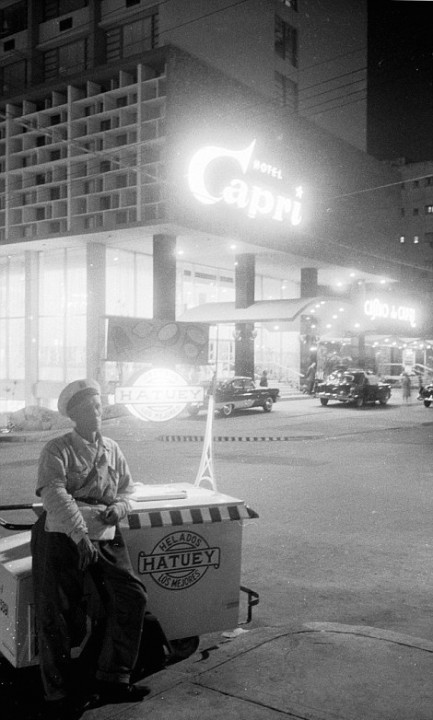 An ice cream vendor patiently waits for potential customers to emerge from the Capri Hotel and Casino, 1958. An ice cream vendor patiently waits for potential customers to emerge from the Capri Hotel and Casino, 1958.
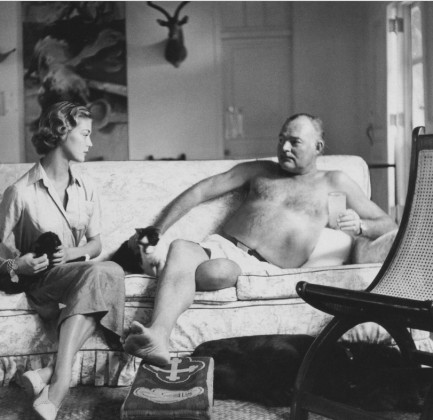 Fashion model Jean Patchett and author Ernest Hemingway, who habitually went shirtless, lounge at Finca Vigia, his house in Cuba, 1950. Fashion model Jean Patchett and author Ernest Hemingway, who habitually went shirtless, lounge at Finca Vigia, his house in Cuba, 1950.
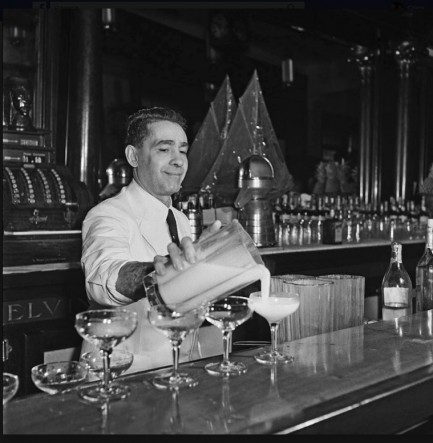 Above, Constantino Ribalaigua Vert, the "Cocktail King of Havana," inventor of the Papa Doble daiquiri, and owner of the famed bar La Floridita. Above, Constantino Ribalaigua Vert, the "Cocktail King of Havana," inventor of the Papa Doble daiquiri, and owner of the famed bar La Floridita.
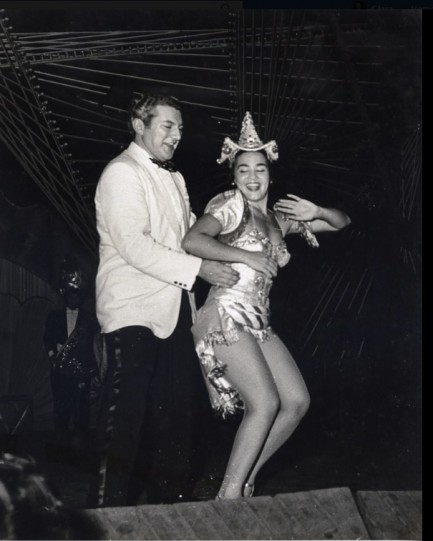 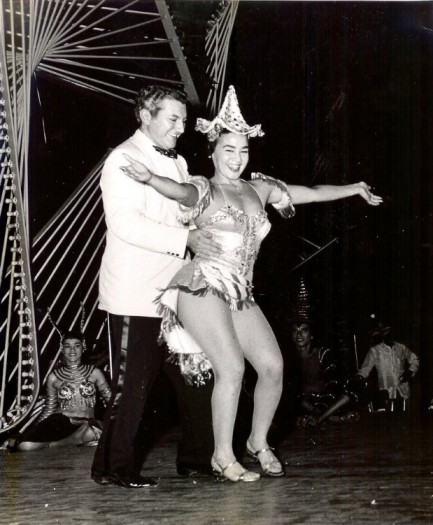 Liberace performs on stage at the Tropicana with headline dancer Ana Gloria Varona, 1954. Liberace performs on stage at the Tropicana with headline dancer Ana Gloria Varona, 1954.
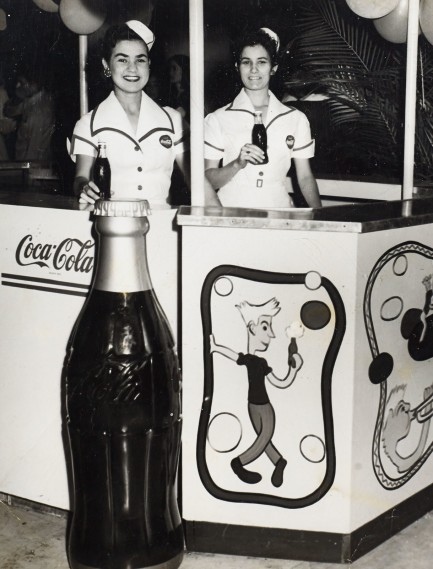 A Coke and a smile from two soft drink vendors. A Coke and a smile from two soft drink vendors.
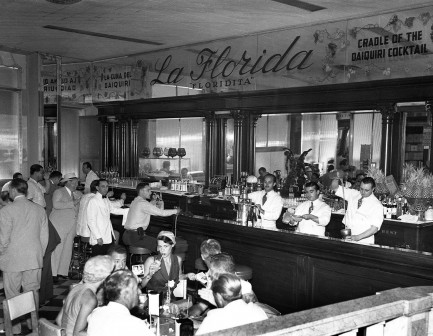 Patrons enjoy drinks at La Floridita, 1955. Patrons enjoy drinks at La Floridita, 1955.
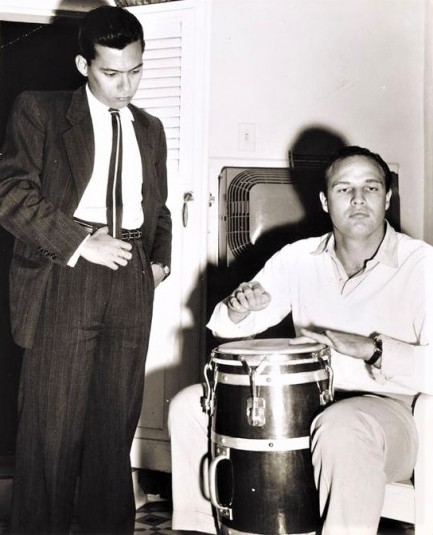 Cuban writer Guillermo Cabrera Infante stands by while Marlon Brando tries his hand—or both of them—at the conga drum at Hotel Packard, 1956. Cuban writer Guillermo Cabrera Infante stands by while Marlon Brando tries his hand—or both of them—at the conga drum at Hotel Packard, 1956.
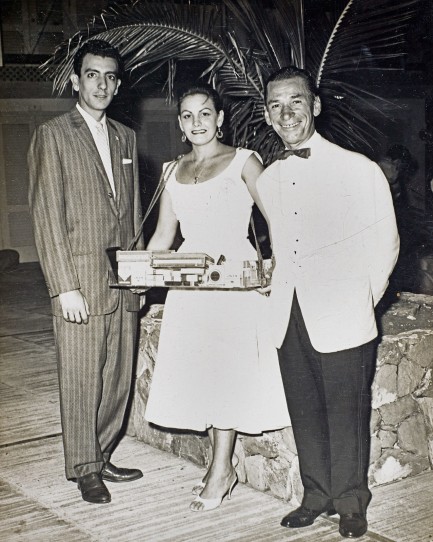 Mafia kingpin Meyer Lansky, on the right in this shot, attends the opening of the Hotel Riviera in December 1957. Mafia kingpin Meyer Lansky, on the right in this shot, attends the opening of the Hotel Riviera in December 1957.
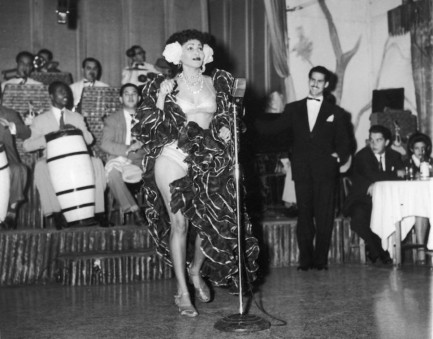 Famed entertainer Zulema dances the rhumba at the Zombie Club, 1946. Famed entertainer Zulema dances the rhumba at the Zombie Club, 1946.
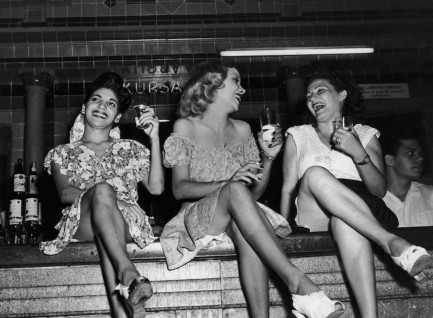 Three women liven up the room from their perch on the bar at Cabaret Kursal. Three women liven up the room from their perch on the bar at Cabaret Kursal.
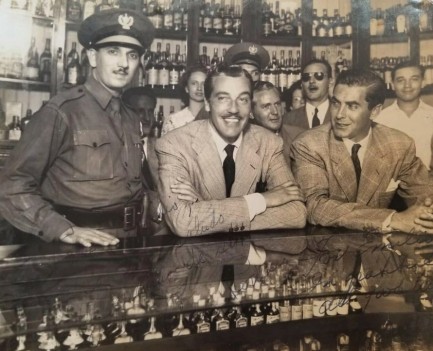 Cesar Romero and Tyrone Power enjoy a drink and a chat at Sloppy Joe's Bar. Cesar Romero and Tyrone Power enjoy a drink and a chat at Sloppy Joe's Bar.
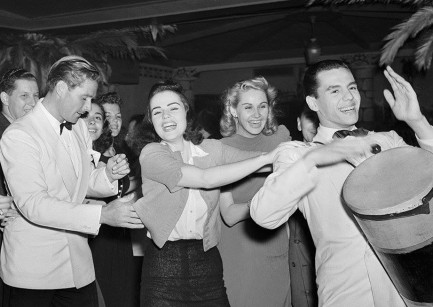 Revelers including Errol Flynn and Desi Arnaz, Jr. form a conga line during the Yoruba festival known as Dia de Babalú-Ayé. Revelers including Errol Flynn and Desi Arnaz, Jr. form a conga line during the Yoruba festival known as Dia de Babalú-Ayé.
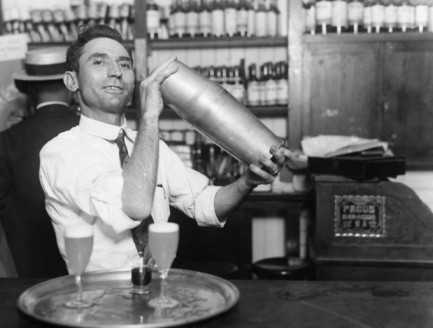 José Abeal Otero, founder of Sloppy Joe's Bar, mixes up a giant batch of liquid magic. No, this isn't the same person as above, Ribalaigua. They were both small, dapper guys. José Abeal Otero, founder of Sloppy Joe's Bar, mixes up a giant batch of liquid magic. No, this isn't the same person as above, Ribalaigua. They were both small, dapper guys.
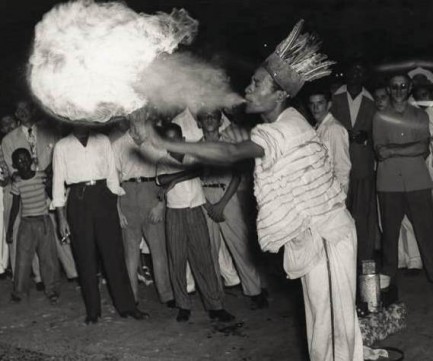 A firebreather thrills onlookers in front of the Saratoga Hotel, 1949. A firebreather thrills onlookers in front of the Saratoga Hotel, 1949.
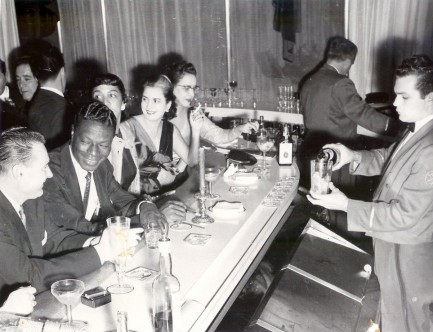 This photo shows Nat King Cole and his wife Maria Cole, along with Martin Fox, who was the owner of the Tropicana, accompanied by his wife Ofelia and an unknown fifth party. This photo shows Nat King Cole and his wife Maria Cole, along with Martin Fox, who was the owner of the Tropicana, accompanied by his wife Ofelia and an unknown fifth party.
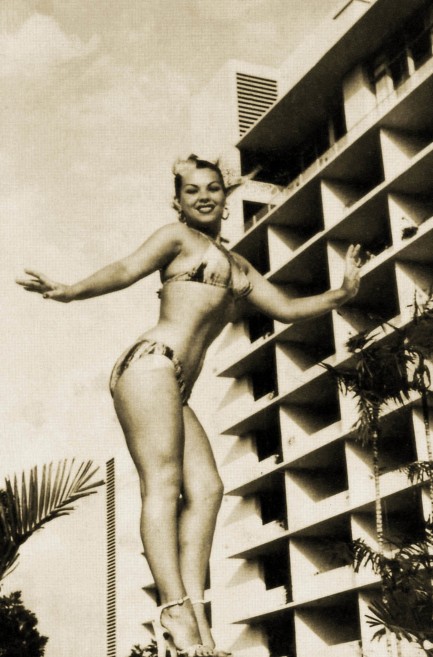 U.S. born vedette and movie star Tongolele, aka Yolanda Montes, poses outside the Capri Hotel and Casino, 1958. U.S. born vedette and movie star Tongolele, aka Yolanda Montes, poses outside the Capri Hotel and Casino, 1958.
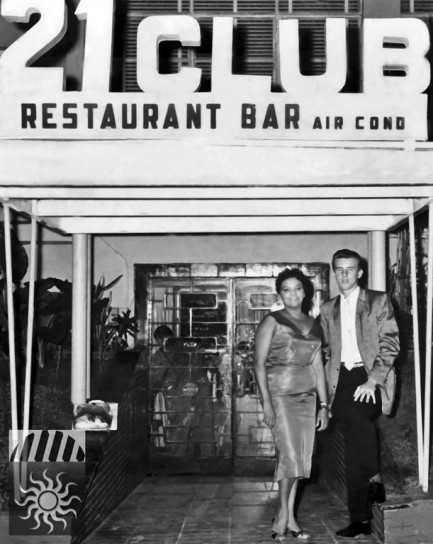 Meme Solis and Elena Burke pose at the entrance to the 21 Club, located in the Capri Hotel. Meme Solis and Elena Burke pose at the entrance to the 21 Club, located in the Capri Hotel.
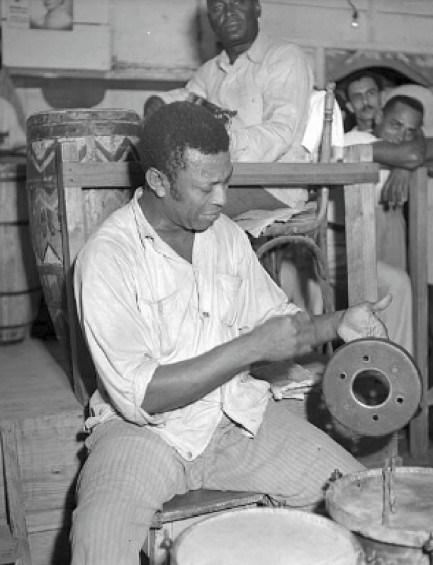 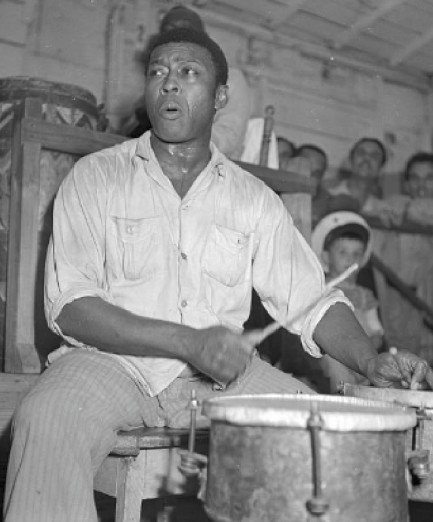 These photos show Silvano Chueg Echevarría, a master of percussion and an iconic musical personage. Let's go back to that Marlon Brando photo for a sec. Brando was an aficionado of percussive instruments. During that 1956 jaunt to Cuba he made it known that he wanted to buy drums from real percussionists. One of the musicians he met was Echevarría. All the Havana percussionists knew of Brando, of course, but thought he was a musical dilettante. At some point he finagled his way onto a nightclub stage, sat in with a band, and truly amazed onlookers with his ability on the conga. He wasn't a master, but he was pretty good. He won respect, and bought his drums. These photos show Silvano Chueg Echevarría, a master of percussion and an iconic musical personage. Let's go back to that Marlon Brando photo for a sec. Brando was an aficionado of percussive instruments. During that 1956 jaunt to Cuba he made it known that he wanted to buy drums from real percussionists. One of the musicians he met was Echevarría. All the Havana percussionists knew of Brando, of course, but thought he was a musical dilettante. At some point he finagled his way onto a nightclub stage, sat in with a band, and truly amazed onlookers with his ability on the conga. He wasn't a master, but he was pretty good. He won respect, and bought his drums.
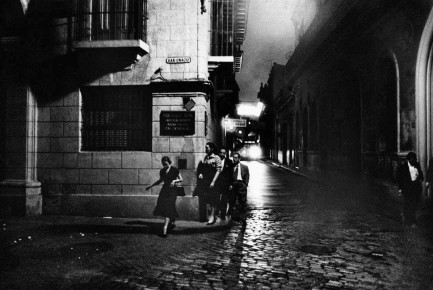 Raquel Revuelta, Manuel Corrales, and Mariano Rodriguez leave the famed bar Bodeguita del Medio and walk through the Havana night to other locales, other adventures, 1958. Raquel Revuelta, Manuel Corrales, and Mariano Rodriguez leave the famed bar Bodeguita del Medio and walk through the Havana night to other locales, other adventures, 1958.
 Ancient Zapotec treasures bring out the tomb raider in everyone. 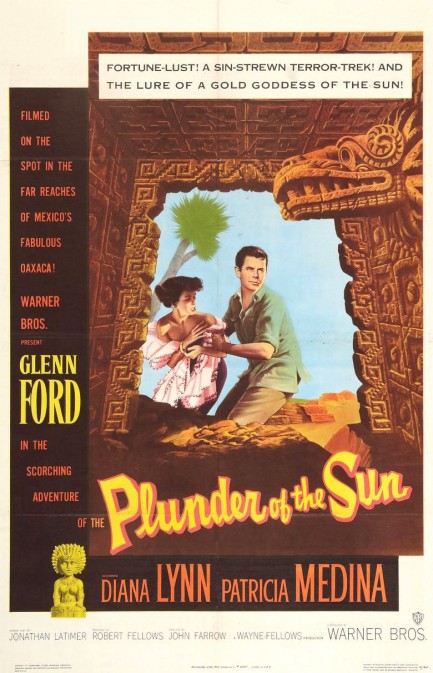
This poster was made for the 1953 adventure Plunder of the Sun, a title which may sound familiar from David Dodge's 1951 novel. The movie starred Glenn Ford, Patricia Medina, and Diana Lynn, and follows the basic gold hunting theme of the book, but with numerous plot details altered, and the exotic locations around Latin America—particularly Peru—condensed to only Havana and the province of Oaxaca, Mexico. The Havana scenes were shot in Mexico, but the Oaxaca scenes were indeed shot in southeastern Mexico, with location work at the Zapotec ruins in Monte Alban. You can practically hear the head honcho at Wayne-Fellows Productions saying, “I love this book, but we've got to make it cheaper. Why go all the way to Peru when there are perfectly good ruins in Mexico?” The Oaxaca locations are great, though, and extensively used, which really helps the film. Are we saying Plunder of the Sun is good? Well, no we aren't. It doesn't have the depth needed to earn a place in the top ranks of vintage cinema, but it's well shot, and its proto-Indiana Jones feel is interesting enough to keep you watching. We have a few promo images below, and you can learn more about the plot by checking our write-up on the novel here. 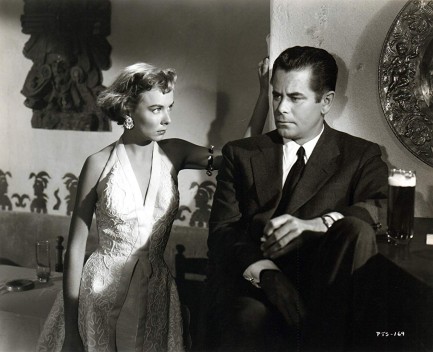 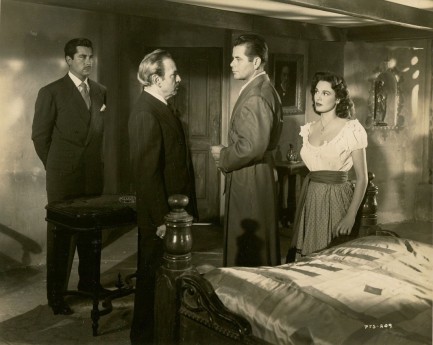 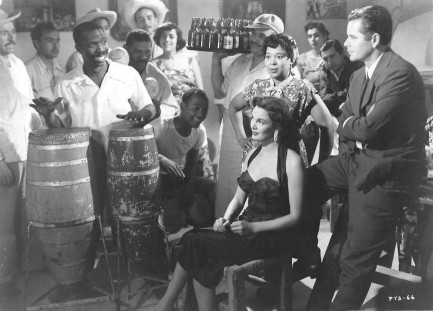 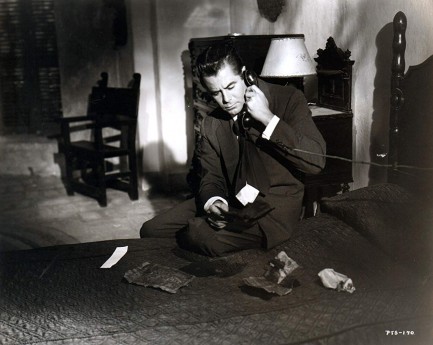 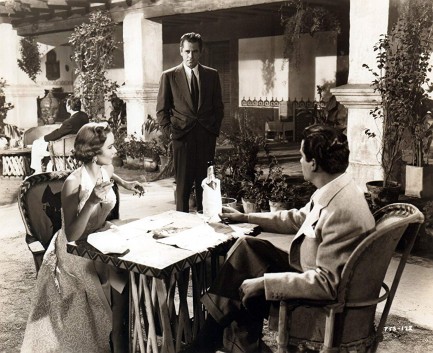 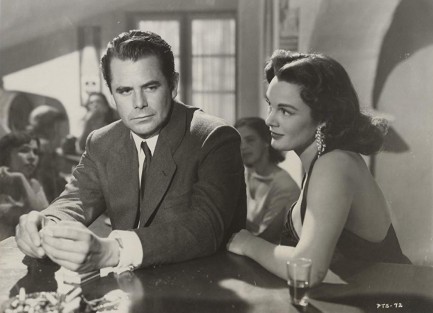 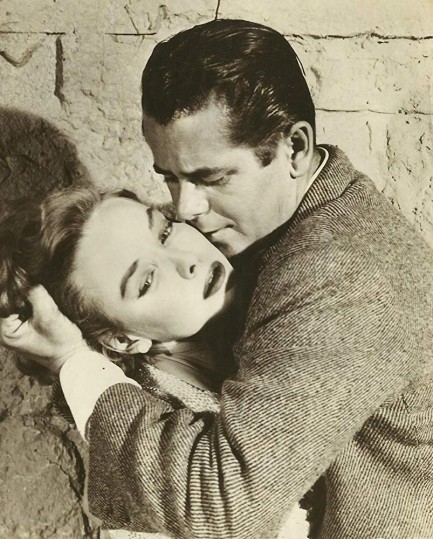 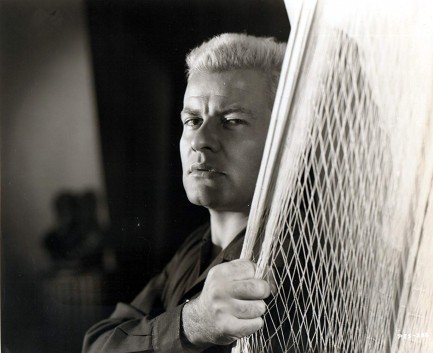 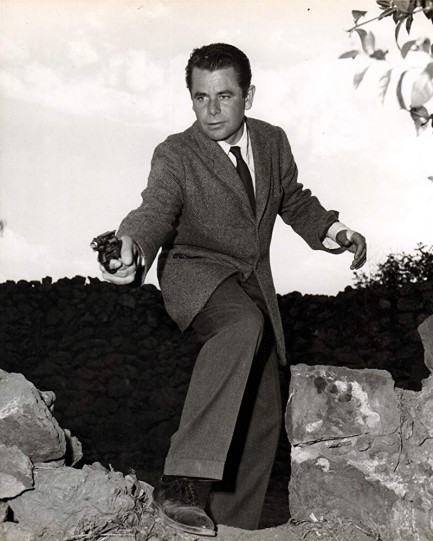 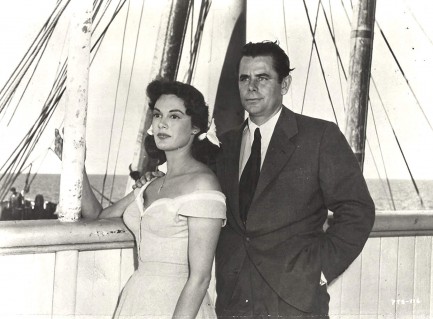 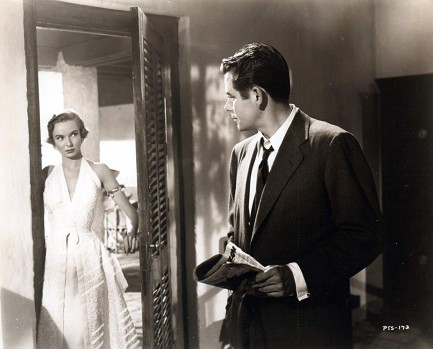 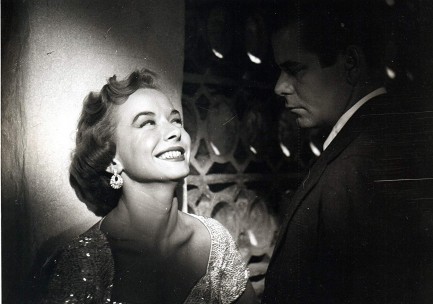 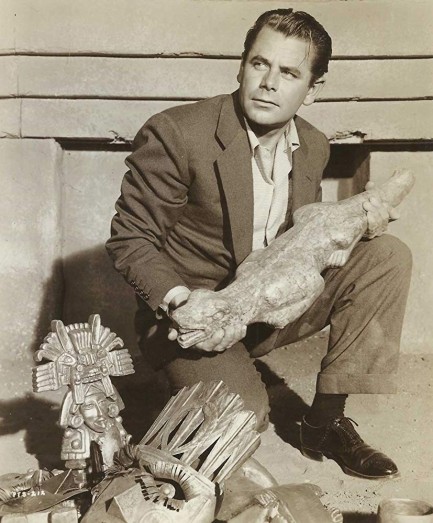
 They both like the beach, poetry, spicy food, and slaughtering cruel despots. They'll make a perfect couple. 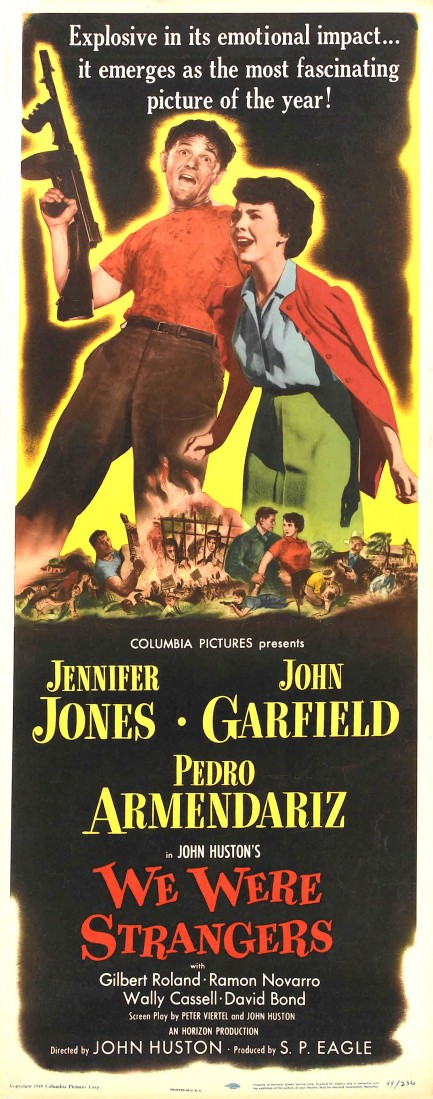 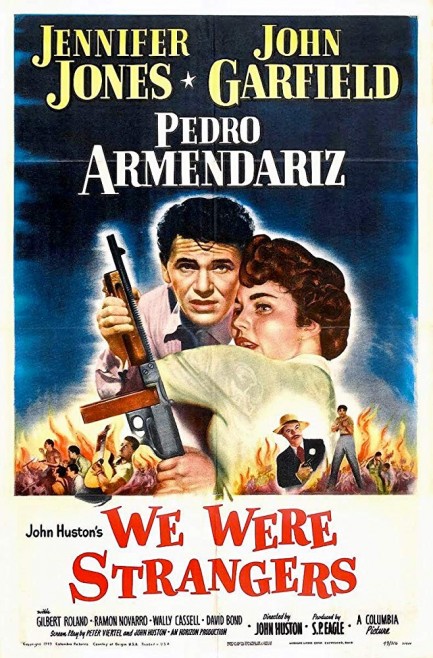
The above posters for We Were Strangers, one of which seems celebratory and another that is more dramatic, could give the impression of a studio that wasn't sure what kind of film it was trying to market. Legendary director John Huston made a habit of confounding executive suites, and here produced a film that probably came close to sending studio bigwigs plummeting in despair off high ledges. The story is set in Cuba during the early 1930s rule of dictator Gerardo Machado y Morales, and deals with revolutionaries who devise a plot to tunnel from a house near a graveyard to the site of a funeral they know the president will attend, and blow him to kingdom come with dynamite.
The movie stars John Garfield and Jennifer Jones, and is beautifully shot, but the characters aren't well written, nor are the performances sufficiently involving. There's nice action, though, especially at the climax. Since the central personalities are revolutionaries in Cuba, many critics denounced the film as Marxist propaganda, which it really isn't. It's just historical drama with unavoidable economic context. You wouldn't think it would be terribly controversial to say that for Americans to live income-wise far above the global average, substantial portions of the world must remain stuck below it, but on the other hand maybe it's understandable that we want to avoid thinking about how earning a nice profit is usually dependent upon others providing raw goods and hard work dirt cheap.
It's a shame the film isn't good enough to sweeten its message with high level drama and thrills. Huston was a workmanlike director who, despite helming numerous classics, wasn't any sort of auteur. He tried to tell stories in ways he felt was best for the material, but he also loved travel, which led him to accept projects based on the potential for exotic location work. Sometimes, as in The African Queen, he struck gold. Other times, as here, he spent a lot of investment capital and made a lot of Hollywood suits cry. We Were Strangers will be of interest to Havanaphiles, but in what was a famously up and down career, this effort comes out on the lower end of the Huston scale. It premiered in the U.S. today in 1949. 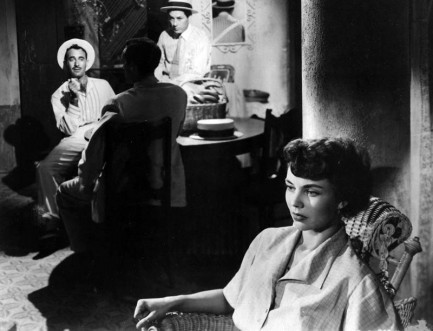 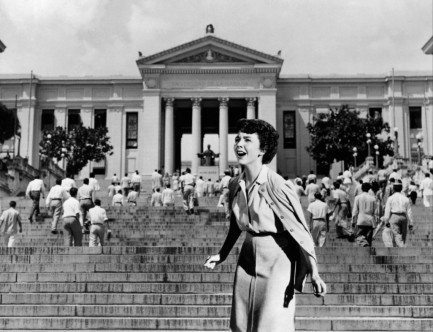 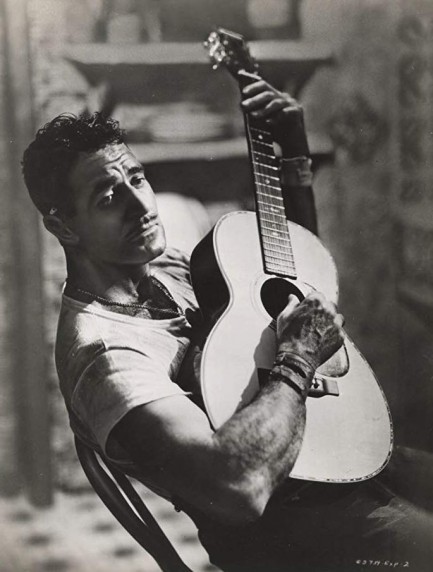 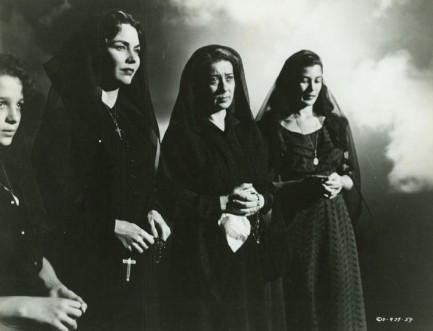 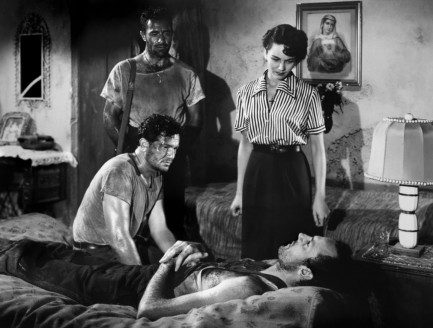 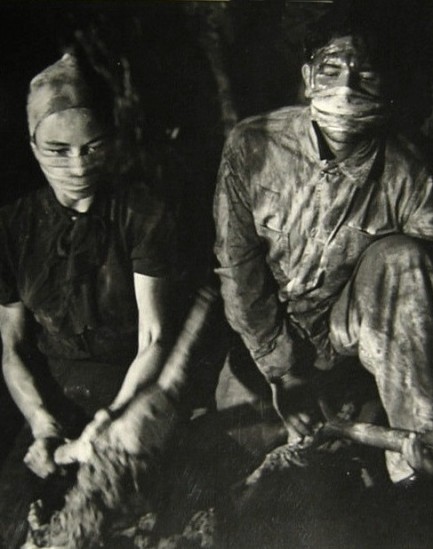
 A signing of things to come. 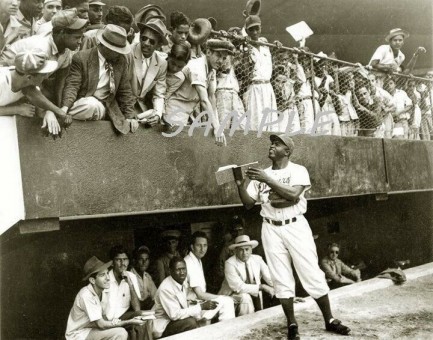
Above is a photo of Brooklyn Dodgers star Jackie Robinson signing autographs for Cuban fans in Havana during the spring of 1947. The Dodgers had used Havana’s La Tropical Stadium as their spring training base during the 1941 and ’42 seasons, and went there again in ’47 to avoid some of the publicity and hostility that would have surrounded Robinson, who was destined to be the first African American baseball player of the modern era. Even away from U.S. shores it was a trying time for Robinson. Havana was run by Americans interests, and was selectively an apartheid city. Robinson stayed at the Hotel Boston in Old Havana, rather than the grand Hotel Nacional in swanky Vedado with the white Dodgers. This annoyed Robinson, but he needed to focus on his play because, though he had been invited to spring training, he was not guaranteed a Major League roster spot. The pressure must have been intense. Even so, in this photo he takes time to sign autographs for Cuban fans, gracious as always, on the cusp of a career that would redefine what it meant to be a Major League Baseball player.
 Is there anything sweeter than a beautiful movie palace? 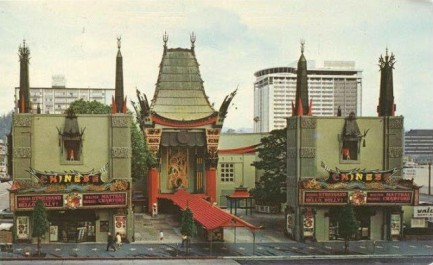
You probably recognize Grauman's Chinese Theatre, in Los Angeles. These days it's called TCL Chinese Theatre, because it's owned and operated by TCL Corporation—based in China, ironically. Since we write so often about movies we thought it appropriate to discuss the beautiful buildings in which the films were exhibited. Back in the day these were usually purpose-built structures, though some did split duty for stage productions and concerts. While many of these old palaces survive, nearly all surviving vintage cinemas in the U.S. were under threat at some point. Generally, if they hadn't been given historic protection they wouldn't be upright today.
Other times, if a city was poor, real estate costs didn't rise and old buildings stood unthreatened, usually idle. This happened often in the American midwest, where movie houses were neglected for decades before some were resurrected amid downtown revitalizations. It sometimes happens in Latin America too, although occasionally the formula fails. For example, Cartagena's majestic and oft photographed landmark Teatro Colón, located in the historic section of Colombia's most popular coastal tourist city, was torn down fewer than six months ago to make way for a Four Seasons Hotel.
Some of the cinemas below are well known treasures, while others are more unassuming places. But even those lesser known cinemas show how much thought and work was put into making moviegoing a special experience. The last photo, which shows the Butterfly Theatre in Milwaukee, exemplifies that idea. The façade is distinguished by a terra cotta butterfly sculpture adorned with light bulbs. As you might guess, many of the most beautiful large cinemas were in Los Angeles, which means that city is well represented in the collection. Enjoy.
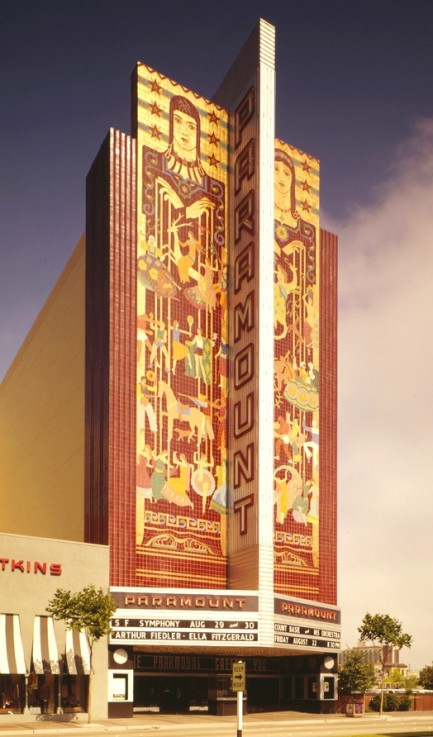 Paramount Theatre, Oakland (operational). Paramount Theatre, Oakland (operational).
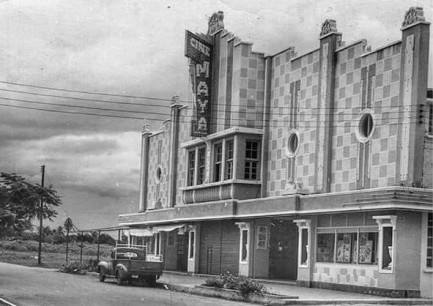 Cine Maya, Mérida (demolished). Cine Maya, Mérida (demolished).
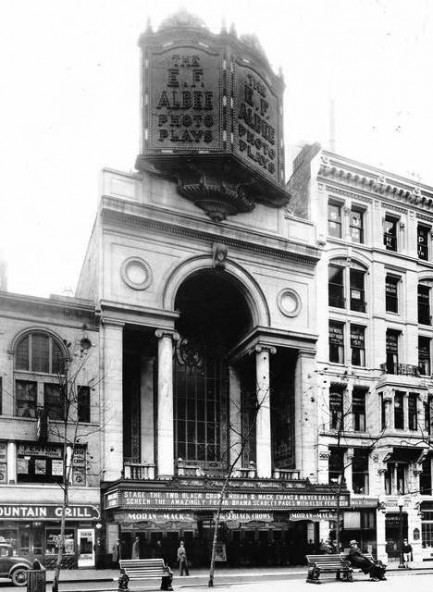 The Albee Cinema, Cincinnati (demolished) The Albee Cinema, Cincinnati (demolished)
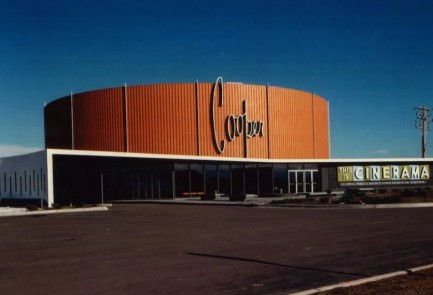 Cooper Theatre, Denver (demolished). Cooper Theatre, Denver (demolished).
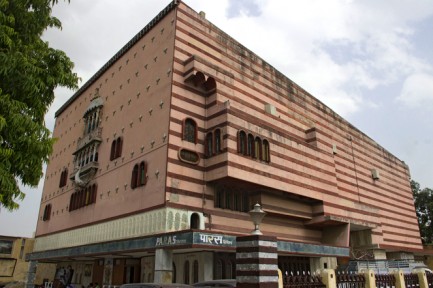 Paras Cinema, Jaipur (operational). Paras Cinema, Jaipur (operational).
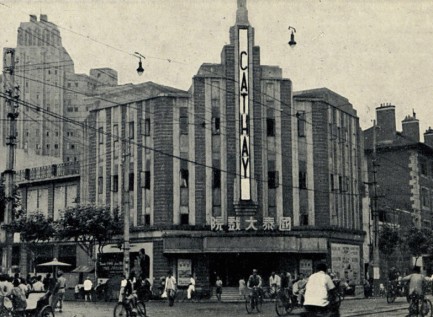 Cathay Cinema, Shanghai (operational). Cathay Cinema, Shanghai (operational).
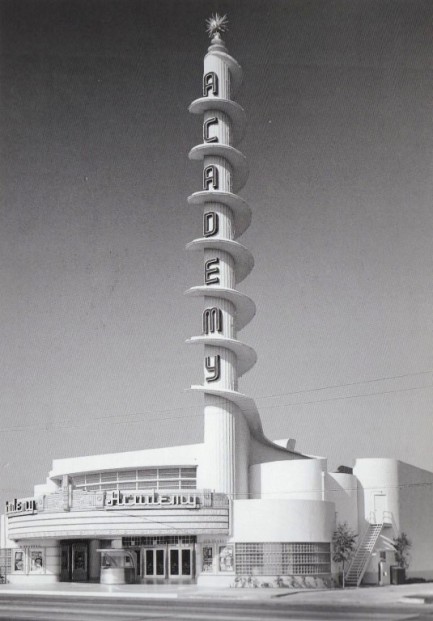 Academy Theatre, Los Angeles (operational). Academy Theatre, Los Angeles (operational).
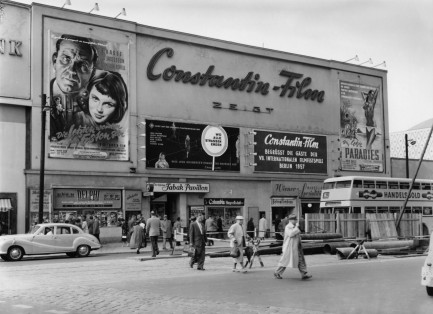 Charlottenburg Filmwerbung, Berlin (demolished). Charlottenburg Filmwerbung, Berlin (demolished).
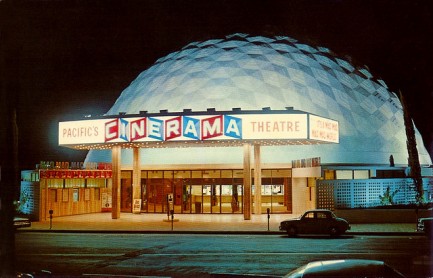 Pacific's Cinerama Theatre, Los Angeles (operational). Pacific's Cinerama Theatre, Los Angeles (operational).
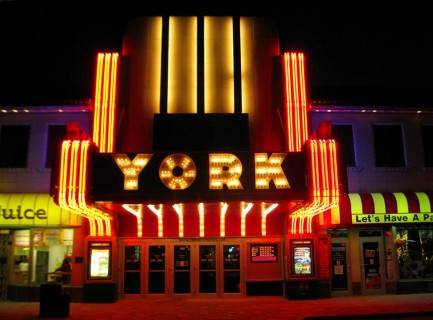 York Theatre, Elmhurst (operational). York Theatre, Elmhurst (operational).
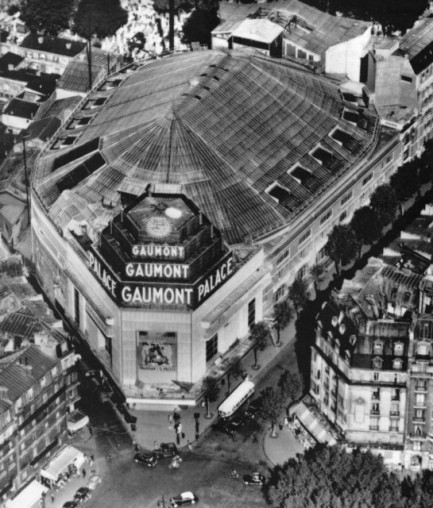 La Gaumont-Palace, Paris (demolished). La Gaumont-Palace, Paris (demolished).
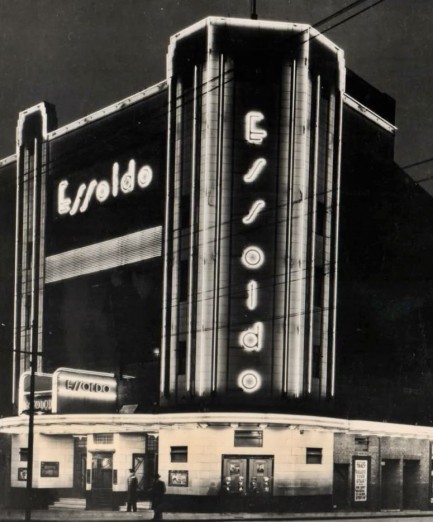 Essoldo Cinema, Newcastle (demolished). Essoldo Cinema, Newcastle (demolished).
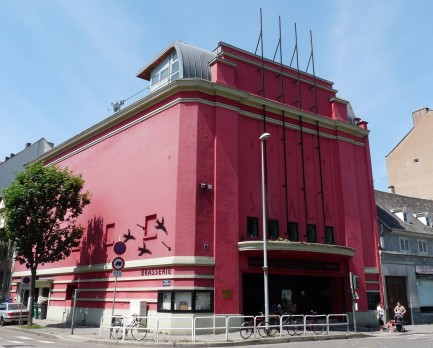 Théâtre Scala, Strasbourg (operational). Théâtre Scala, Strasbourg (operational).
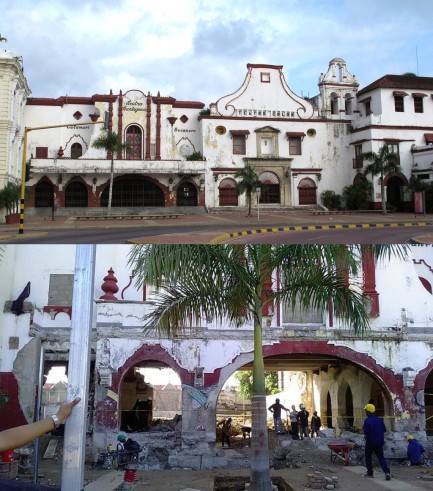 Teatro Colón, Cartagena (demolished in 2018). Teatro Colón, Cartagena (demolished in 2018).
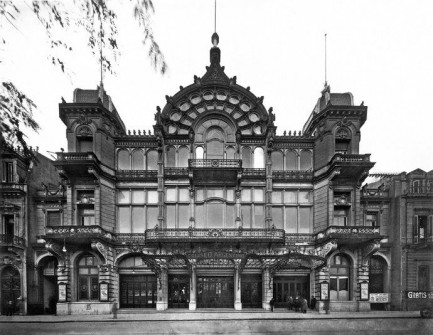 Teatro Coliseo Argentino, Buenos Aires (demolished). Teatro Coliseo Argentino, Buenos Aires (demolished).
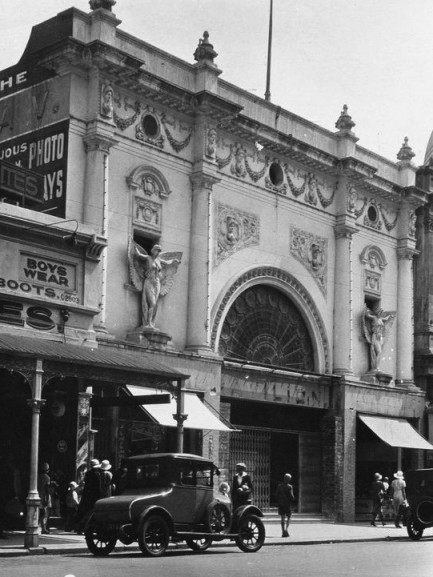 Pavilion Theater, Adelaide (demolished). Pavilion Theater, Adelaide (demolished).
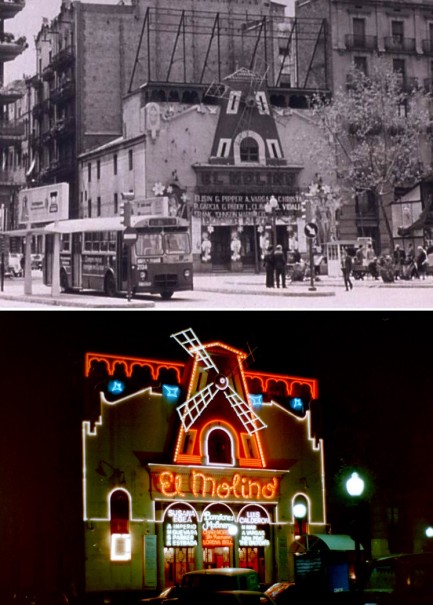 El Molino Teatro, Barcelona (operational). El Molino Teatro, Barcelona (operational).
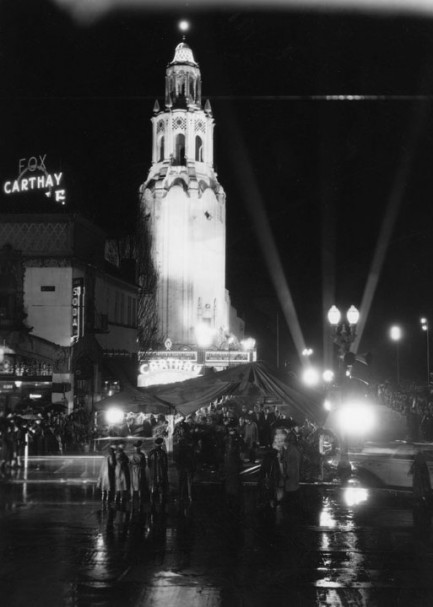 Fox Carthay Theatre, Los Angeles (demolished). Fox Carthay Theatre, Los Angeles (demolished).
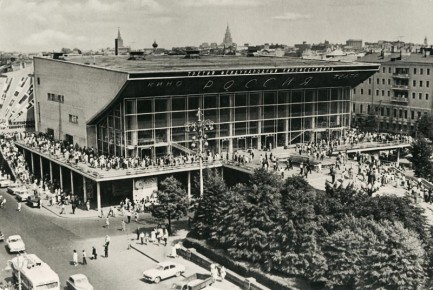 Kino Rossiya Teatr, Moscow (operational). Kino Rossiya Teatr, Moscow (operational).
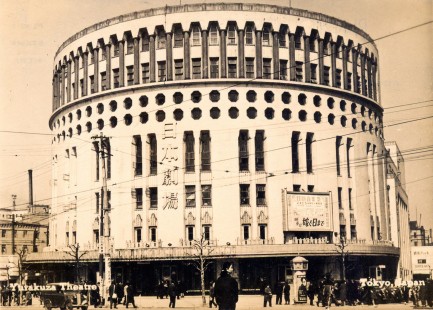 Nippon Gekijo, aka Nichigeki, Tokyo (demolished). Nippon Gekijo, aka Nichigeki, Tokyo (demolished).
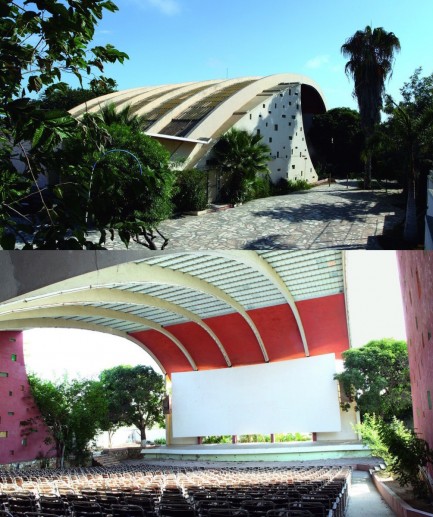 Cine Impala, Namibe (operational). Cine Impala, Namibe (operational).
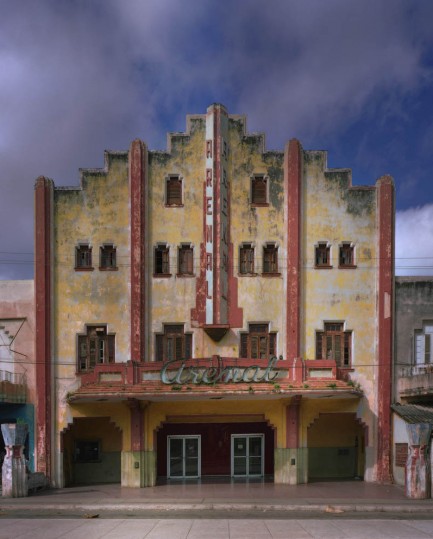 Cine Arenal, Havana (operational). Cine Arenal, Havana (operational).
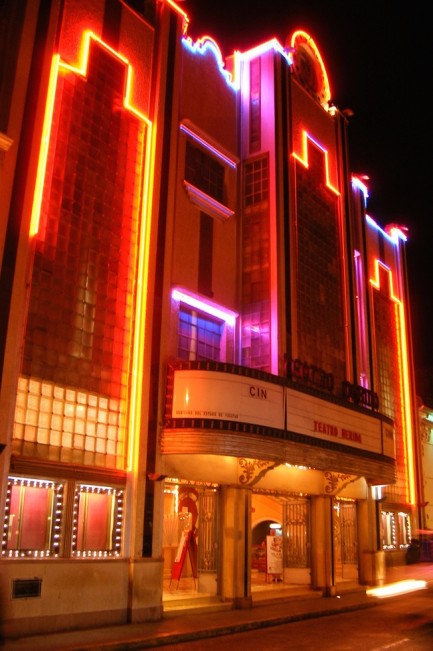 Teatro Mérida, Mérida (operational, renamed Teatro Armando Manzanero). Teatro Mérida, Mérida (operational, renamed Teatro Armando Manzanero).
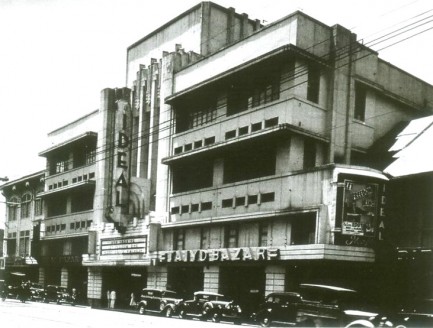 Ideal Theater, Manila (demolished). Ideal Theater, Manila (demolished).
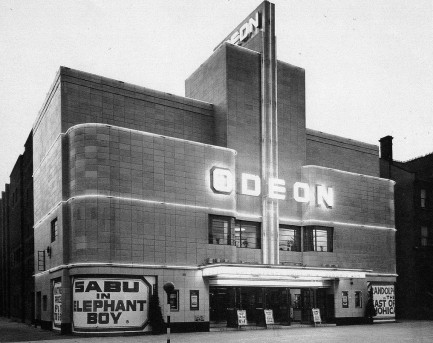 Odeon Cinema, London (semi-demolished, converted to apartments). Odeon Cinema, London (semi-demolished, converted to apartments).
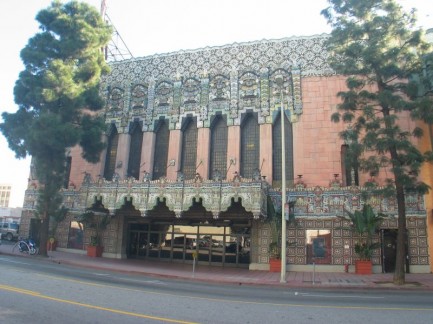 Mayan Theatre, Los Angeles (operational). Mayan Theatre, Los Angeles (operational).
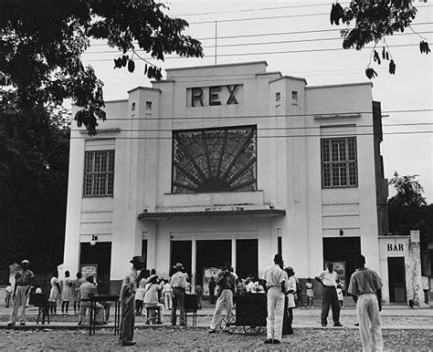 Rex Cinema, Port au Prince (being restored). Rex Cinema, Port au Prince (being restored).
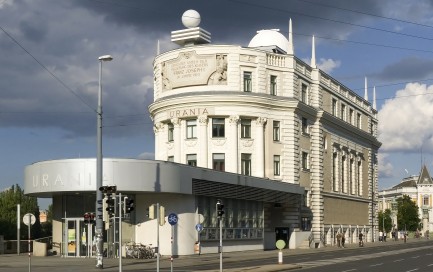 Urania Kino, Vienna (operational). Urania Kino, Vienna (operational).
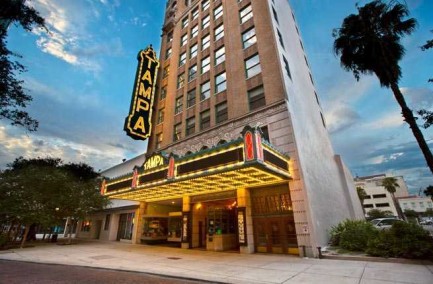 Tampa Theatre, Tampa (operational). Tampa Theatre, Tampa (operational).
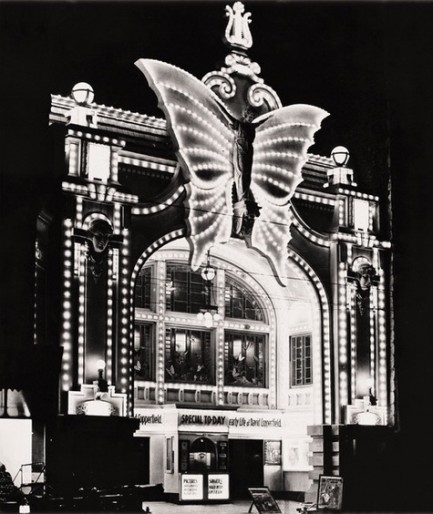 The Butterfly Theater, Milwaukee (demolished). The Butterfly Theater, Milwaukee (demolished).
 Flying through the air with the greatest of ease. 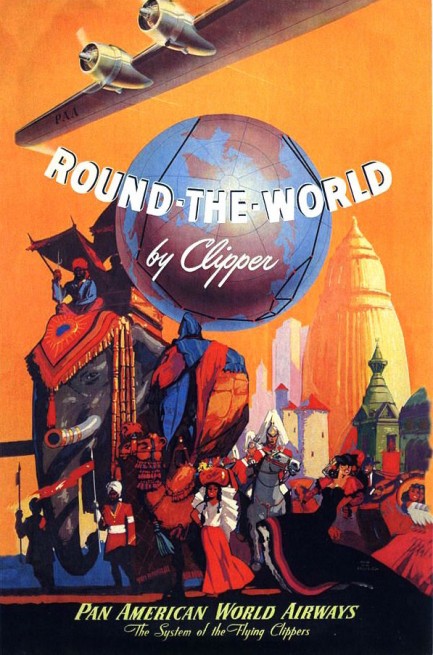
Pan American World Airways knew how to imbue travel with an aura of romance. It launched in the late 1920s with mail service from Key West to Havana, and quickly expanded to become a passenger airline. Business boomed—well heeled Americans took flights to Havana in droves in what became known as the Cocktail Circuit, escaping U.S. prohibition to enjoy a weekend of decadent nightclubs and gambling before returning in time for Monday's real world obligations. Soon Pan Am expanded service throughout Latin America and the world. It bought seaplanes to get around the problem of many cities not having proper airports. With the ability to use docking facilities, virtually no destination was inaccessible. The company dubbed its seaplane fleet “clippers,” evoking the masted sailing ships of the oceangoing era, and their draw was not just their mobility but their luxury. Some say it was a different era of corporate governance, a time when the mandate in the commercial travel industry was to earn loyalty with good service rather than to blackmail customers into avoiding misery. This is partly true, but it's also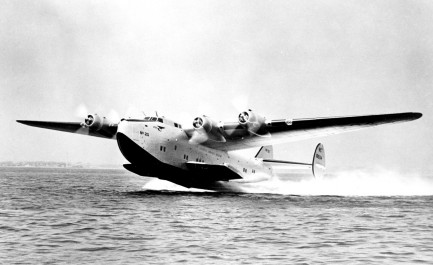 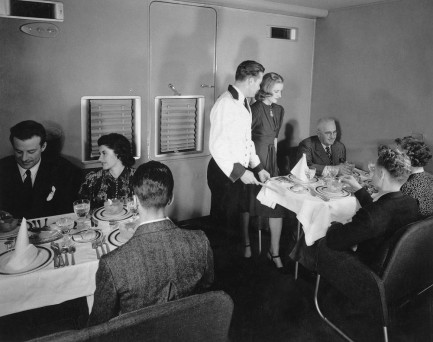 important to remember that air travel was initially considered a luxury indulgence. It was with the advent of travel for the masses that airlines began to exchange services for profitably packing people in like sardines. In that sense, their priorities have not changed much in fifty years. important to remember that air travel was initially considered a luxury indulgence. It was with the advent of travel for the masses that airlines began to exchange services for profitably packing people in like sardines. In that sense, their priorities have not changed much in fifty years.
Pan Am soon began promoting its services with colorful posters, many of which were created by a talented artist named Mark von Arenburg. These prints, which promised to take passengers around the world by clipper, hung mainly in airports and travel agencies and gave passersby fantastic glimpses of faraway destinations—indeed, it's difficult to look at any of them without feeling the pull of the exotic wider world. The company produced hundreds of these promos in various styles and multiple languages, but for our purposes we're interested today only in the posters advertising travel on that elegant Pan Am clipper. Over the years the fleet evolved from seaplanes to jets, and while all were called clippers, it's the lovely skyboats that are most fondly remembered—and which provided so many entertaining settings in old movies and pulp fiction. The posters you see below are scans of both originals and reproductions, and there are quite a few. Even so, it isn't a complete collection. Some of the most famous posters are so rare they simply can't be found online at the moment. While it's true that air travelers are mainly treated like cattle rather than customers today, and commercial flying is a form of voluntary torture, the destinations are still there to make those difficult hours in the air worthwhile. Let these posters inspire you. 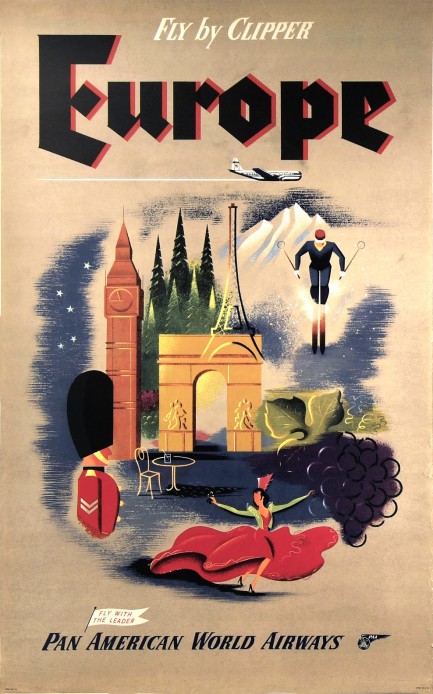 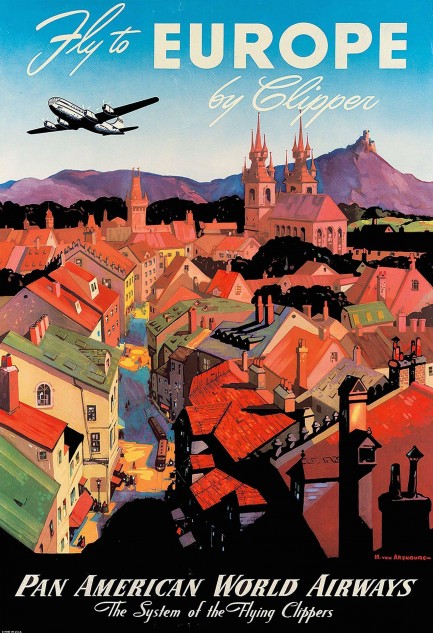 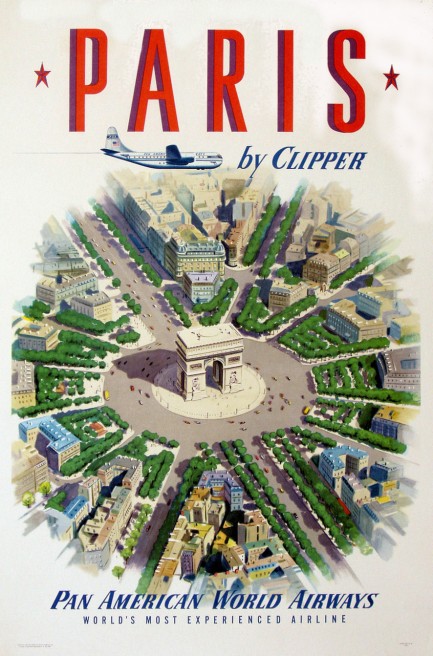 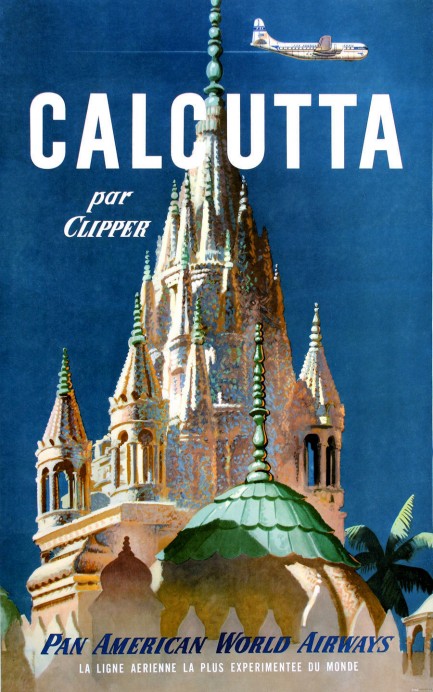 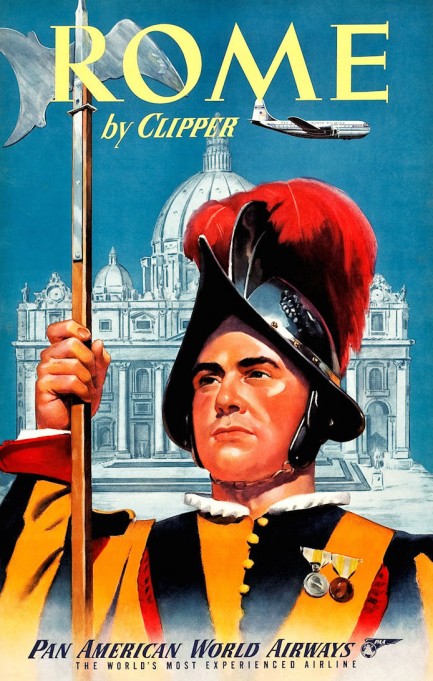 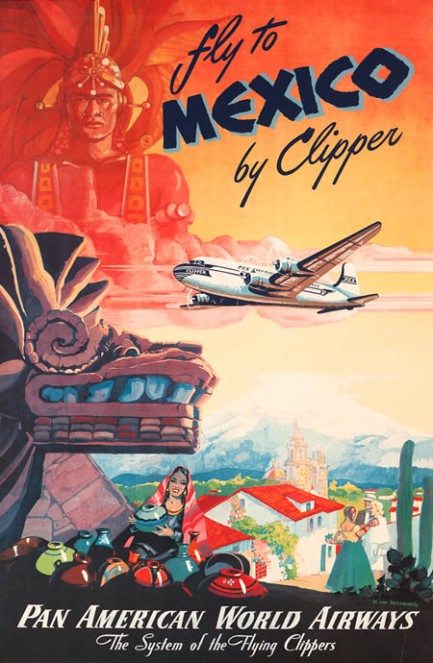 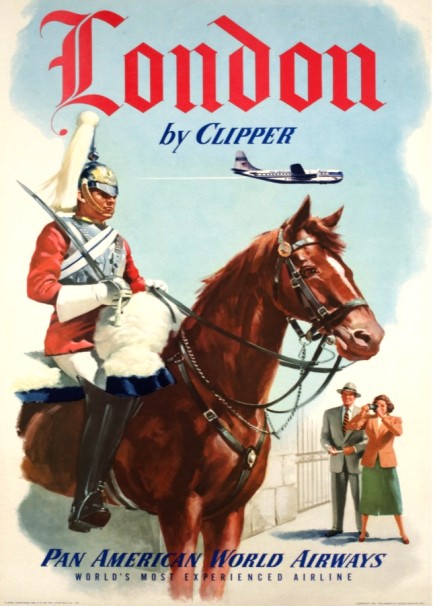 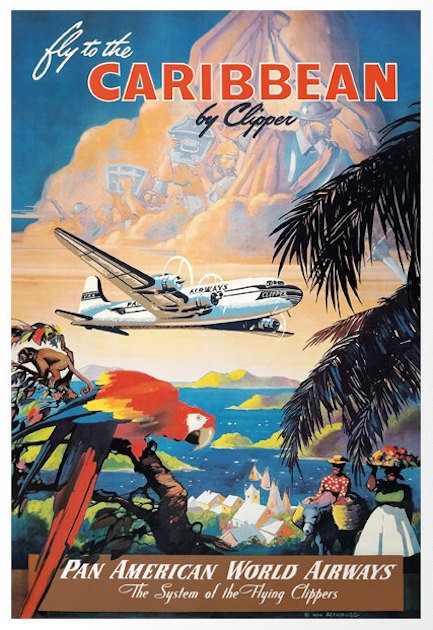 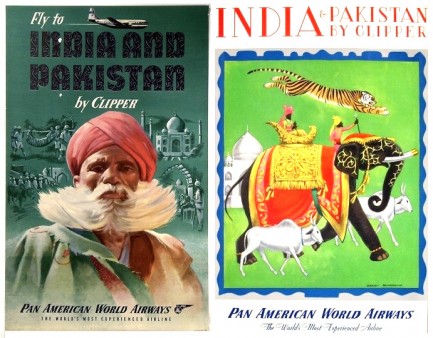 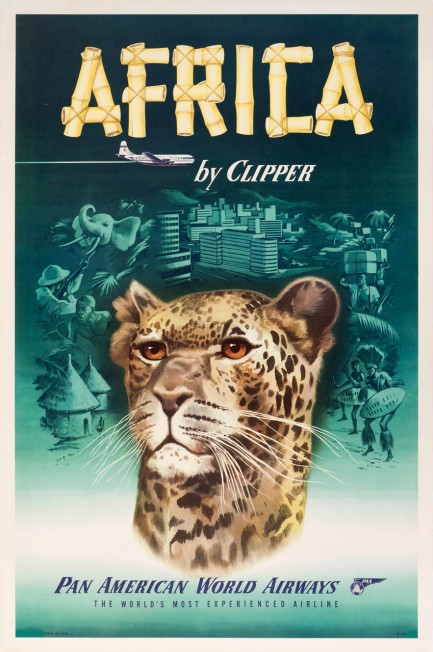 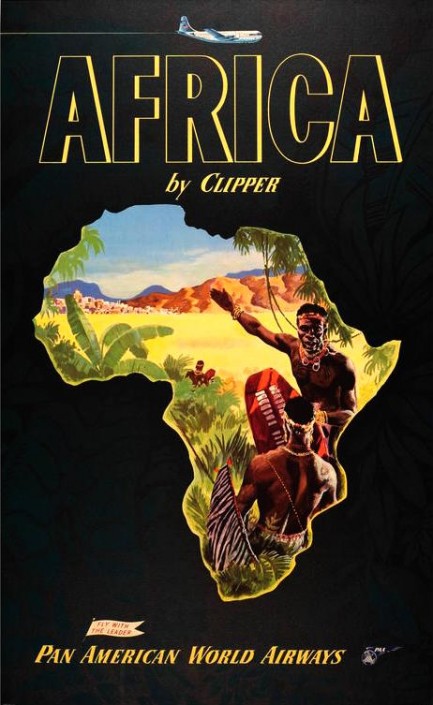 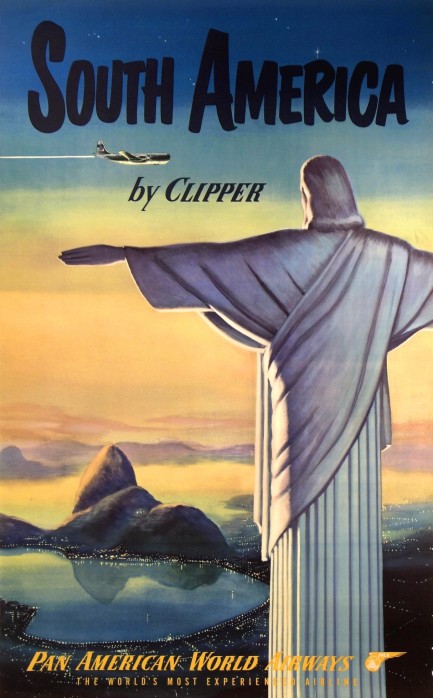 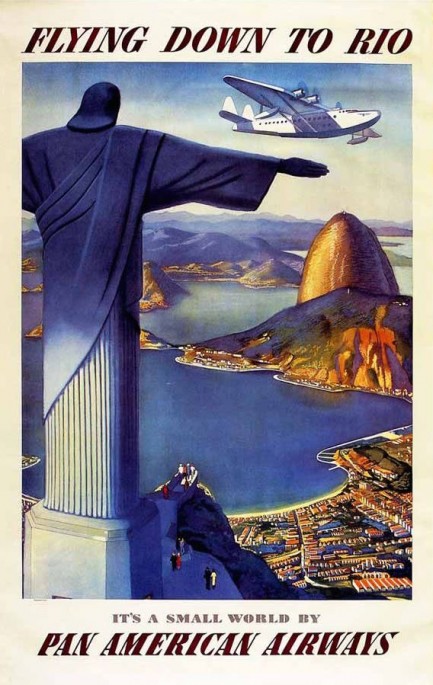 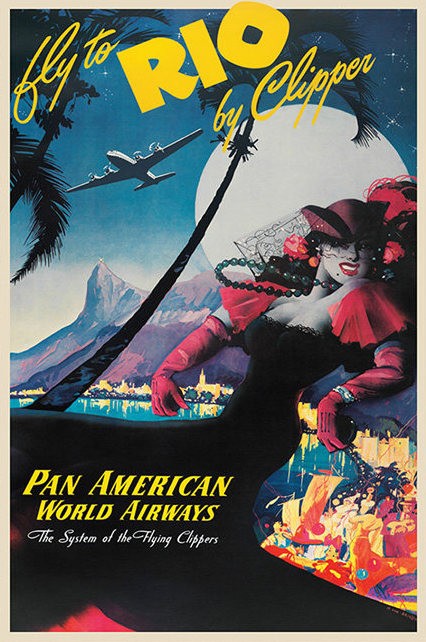 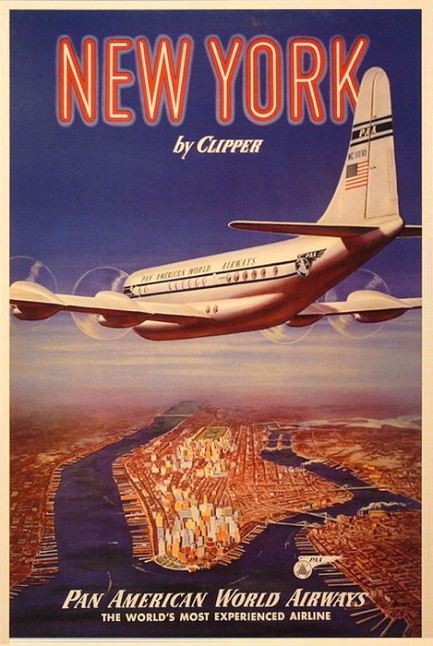 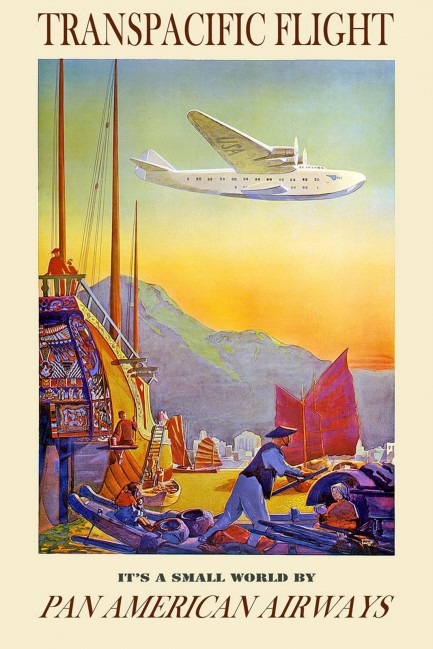 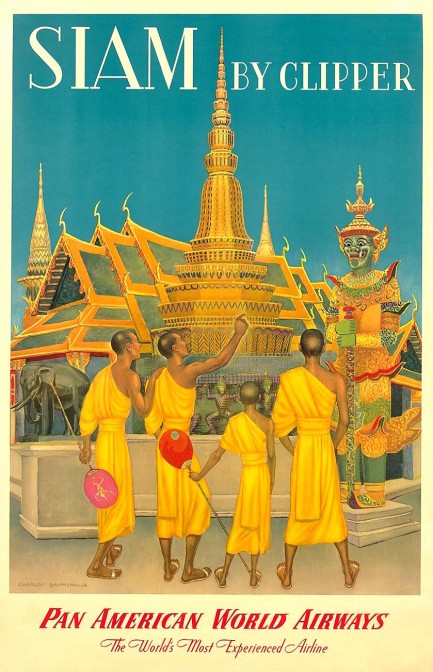 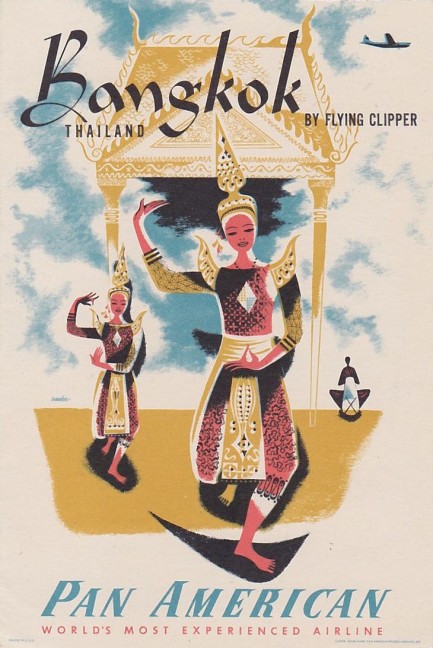 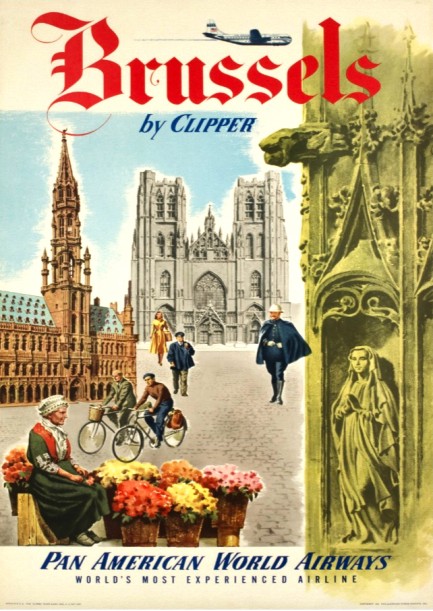 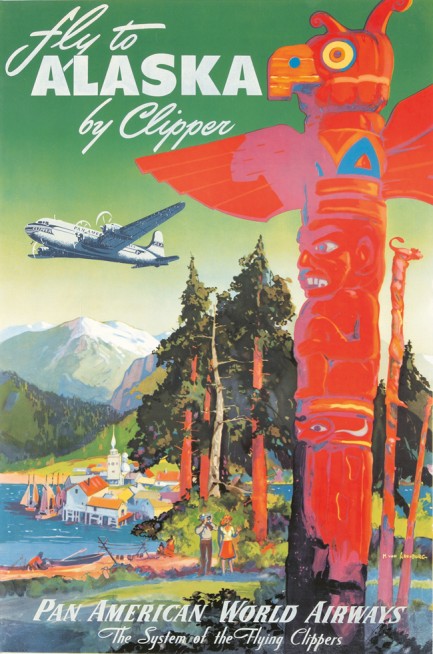 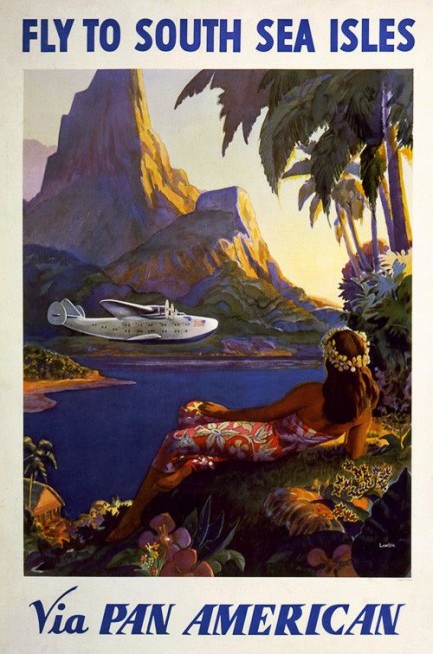 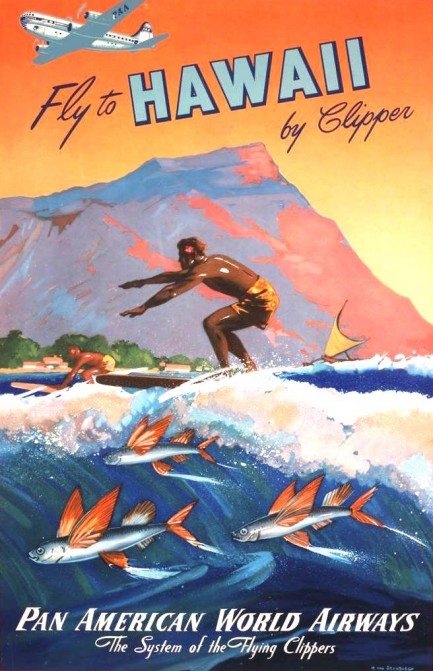 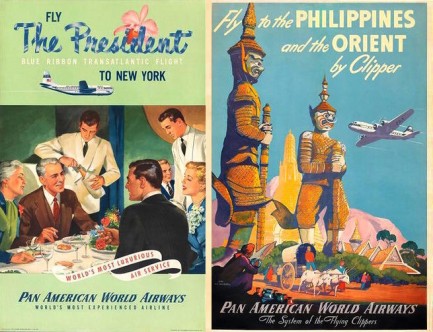 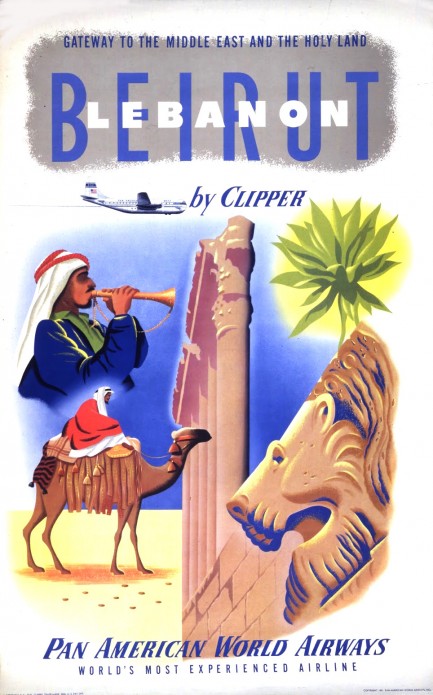 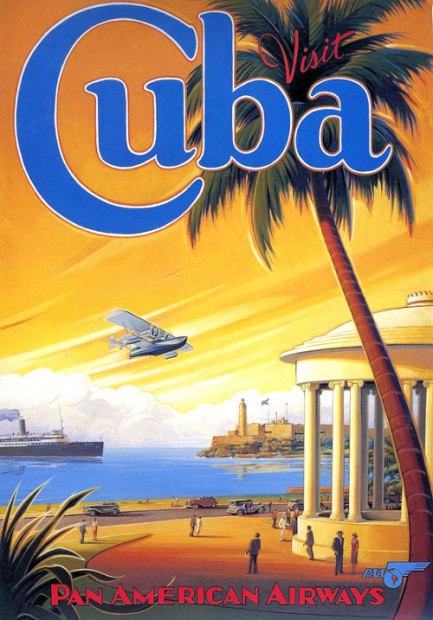 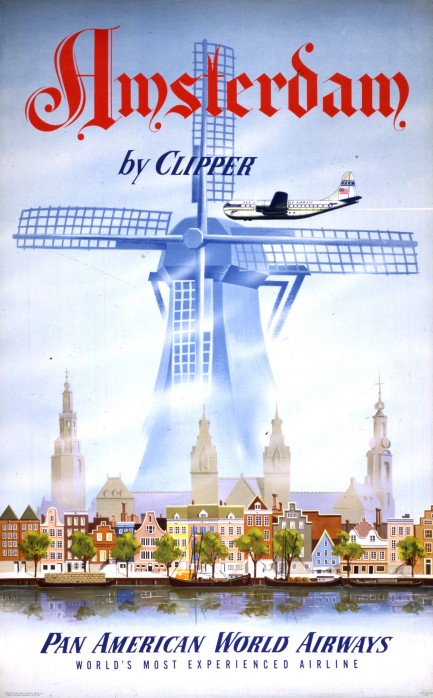 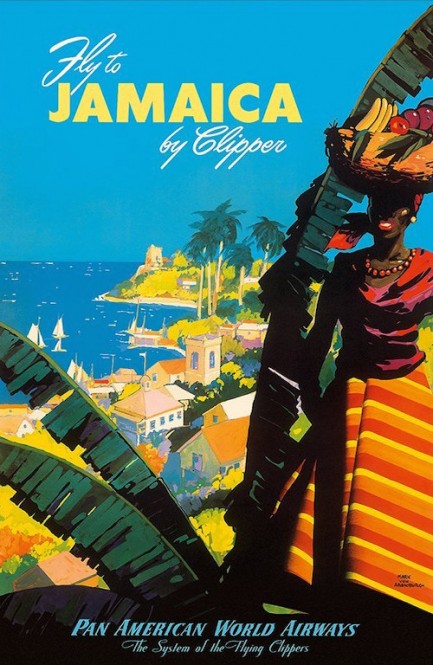 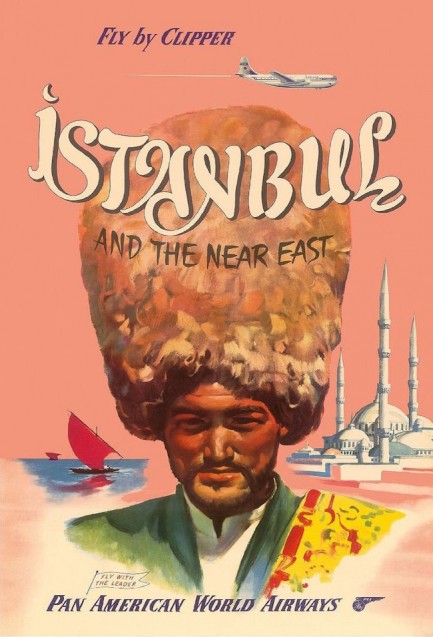 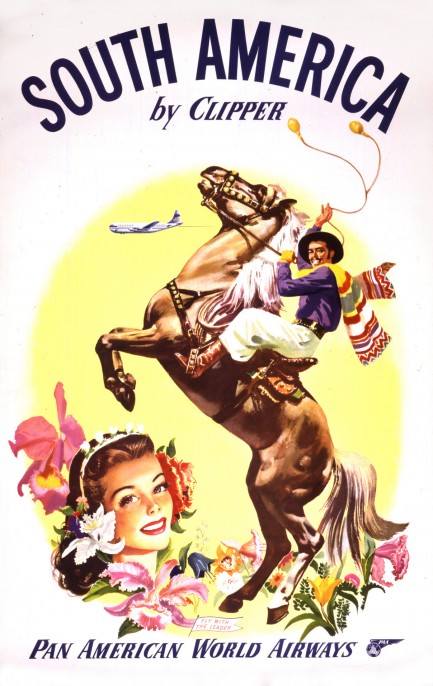 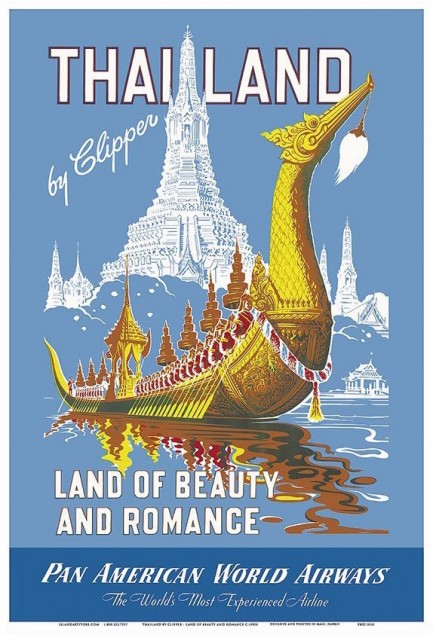 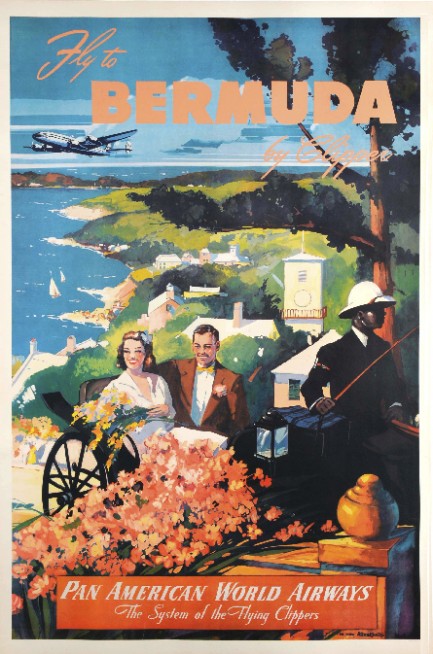 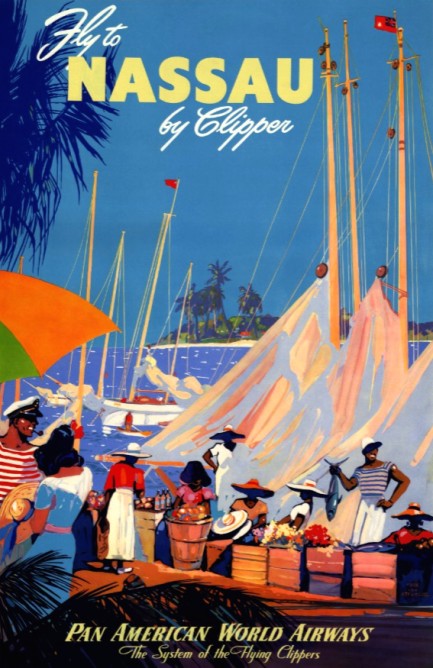 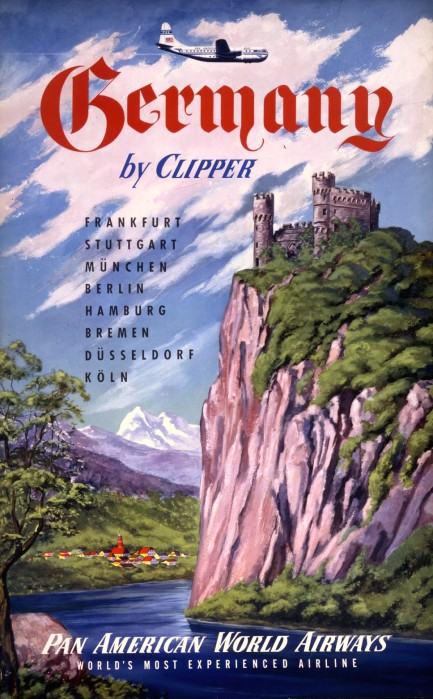 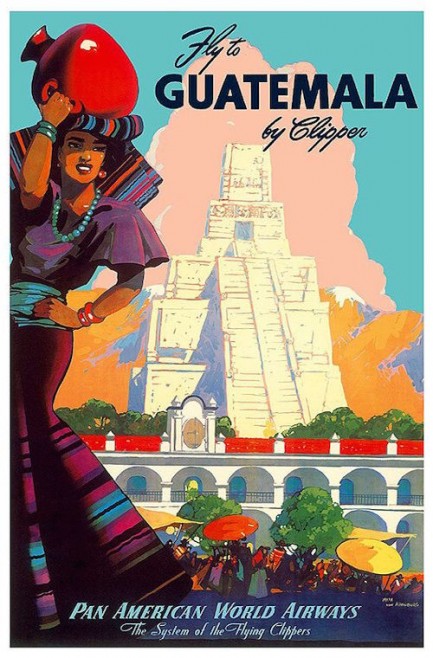 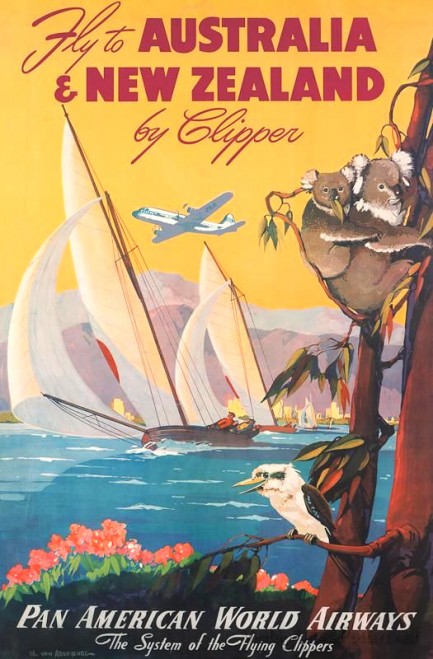 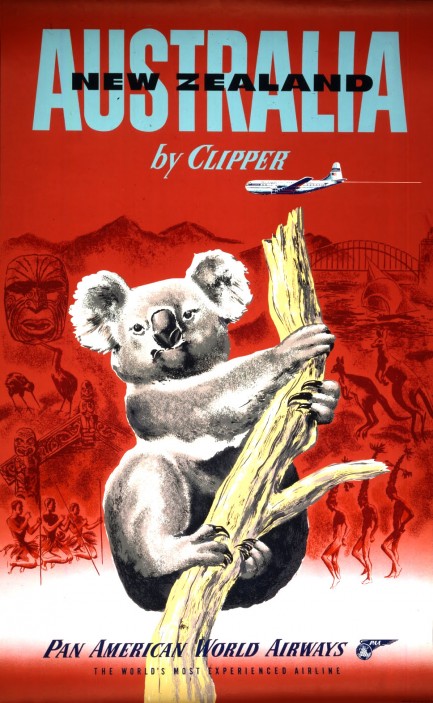
 Havana shopping street catered to the international upper crust. 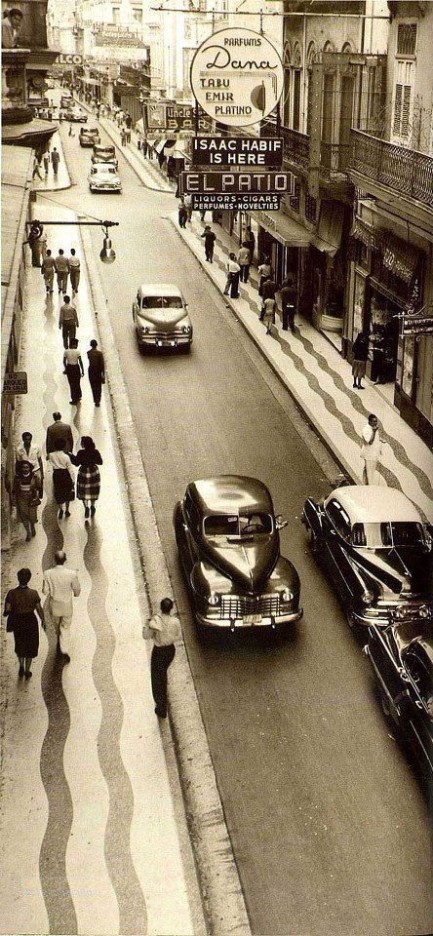
We're back from vacation. We were surrounded by colonial era architecture, which brought to mind this photo of Havana, Cuba, a former colonial city thousands of miles from where we were, but similar in many respects. The shot was taken along Calle San Rafael sometime during the 1940s. There's a lot of detail in this—in the distance we can see Bar Uncle Sam and a Philco store, and in the foreground the cars and flowing sidewalk mosaics are interesting too. Of particular note is the perfume store El Patio, where a sign tells us the Dana brands Emir, Tabu, and Platino are available. These were pricy concoctions, affordable for only the rare few, sold by a fancy perfumer that got its start in Barcelona back in 1932. Presumably Isaac Habif was a perfume or cologne too, but we can't find mention of it anywhere. Some of the other businesses on San Rafael included the swank coffee shop Salon H, top jewelers Letrán de Isaac Barquet, Cuervo y Sobrinos, and Gastón Bared, two academies—Academia Pitman and Academia Gregg—which were expensive and private, the department stores Fin de Siglo and El Encanto, Indochina, which was an exotic gift shop, the eyewear boutique El Telescopio, and La Exposición, which sold furs—yes, in that climate. In all, Calle San Rafael wasn't just an ordinary thoroughfare, but a major shopping street serving Havana's economic elite. It remains a shopping street today, but the mosaics and fine brands are long gone. For a bit more on colonial era Havana, have a look here. And for an interesting array of post-revolutionary photos, look here.

|
 |

The headlines that mattered yesteryear.
1945—Mussolini Is Arrested
Italian dictator Benito Mussolini, his mistress Clara Petacci, and fifteen supporters are arrested by Italian partisans in Dongo, Italy while attempting to escape the region in the wake of the collapse of Mussolini's fascist government. The next day, Mussolini and his mistress are both executed, along with most of the members of their group. Their bodies are then trucked to Milan where they are hung upside down on meathooks from the roof of a gas station, then spat upon and stoned until they are unrecognizable. 1933—The Gestapo Is Formed
The Geheime Staatspolizei, aka Gestapo, the official secret police force of Nazi Germany, is established. It begins under the administration of SS leader Heinrich Himmler in his position as Chief of German Police, but by 1939 is administered by the Reichssicherheitshauptamt, or Reich Main Security Office, and is a feared entity in every corner of Germany and beyond. 1937—Guernica Is Bombed
In Spain during the Spanish Civil War, the Basque town of Guernica is bombed by the German Luftwaffe, resulting in widespread destruction and casualties. The Basque government reports 1,654 people killed, while later research suggests far fewer deaths, but regardless, Guernica is viewed as an example of terror bombing and other countries learn that Nazi Germany is committed to that tactic. The bombing also becomes inspiration for Pablo Picasso, resulting in a protest painting that is not only his most famous work, but one the most important pieces of art ever produced. 1939—Batman Debuts
In Detective Comics #27, DC Comics publishes its second major superhero, Batman, who becomes one of the most popular comic book characters of all time, and then a popular camp television series starring Adam West, and lastly a multi-million dollar movie franchise starring Michael Keaton, then George Clooney, and finally Christian Bale. 1953—Crick and Watson Publish DNA Results
British scientists James D Watson and Francis Crick publish an article detailing their discovery of the existence and structure of deoxyribonucleic acid, or DNA, in Nature magazine. Their findings answer one of the oldest and most fundamental questions of biology, that of how living things reproduce themselves.
|

|
|

It's easy. We have an uploader that makes it a snap. Use it to submit your art, text, header, and subhead. Your post can be funny, serious, or anything in between, as long as it's vintage pulp. You'll get a byline and experience the fleeting pride of free authorship. We'll edit your post for typos, but the rest is up to you. Click here to give us your best shot.

|
|


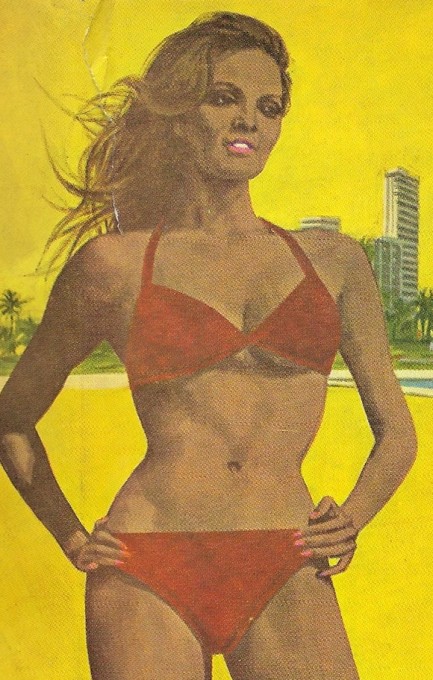
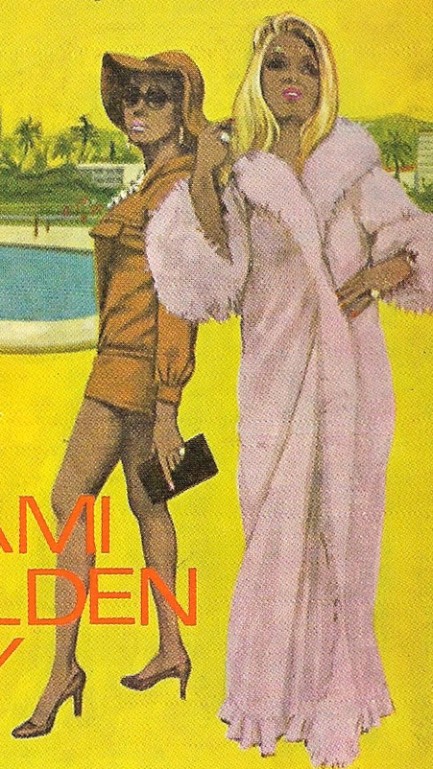




 sonic or energy weapons, and the American press is pretty much dismissing those claims, you keep the pressure on. Some experts note that sonic weapon frequencies wouldn't be recordable, and the enemy attack theory is thus unaffected. In other words, the recordings given to JASON scientists weren't of the actual phenomenon in question. Well, okay, but we prefer crickets. Please let it be crickets. Or maybe the answer is twofold. Maybe Havana Syndrome is caused by crickets trained by Cuba or Russia. Bet those egghead scientists didn't even think of that.
sonic or energy weapons, and the American press is pretty much dismissing those claims, you keep the pressure on. Some experts note that sonic weapon frequencies wouldn't be recordable, and the enemy attack theory is thus unaffected. In other words, the recordings given to JASON scientists weren't of the actual phenomenon in question. Well, okay, but we prefer crickets. Please let it be crickets. Or maybe the answer is twofold. Maybe Havana Syndrome is caused by crickets trained by Cuba or Russia. Bet those egghead scientists didn't even think of that.

 as a great place to go for thrills. During the 1980s, Ibiza or Mykonos. The 90s, Thailand or Goa. The 00s, Tulum. Havana wasn't unusual in terms of what it offered. Bigger, yes. More convenient for Americans, for sure. But numerous far flung locales have served as paradises for foreign visitors to lose themselves and get crazy.
as a great place to go for thrills. During the 1980s, Ibiza or Mykonos. The 90s, Thailand or Goa. The 00s, Tulum. Havana wasn't unusual in terms of what it offered. Bigger, yes. More convenient for Americans, for sure. But numerous far flung locales have served as paradises for foreign visitors to lose themselves and get crazy. type of expatriate experience. It's unavoidable. A friend of ours lived in a stick shack on Cayos Cochinos for an entire year and he was still considered a rich foreigner. Everyone knows you have a choice. The Americans who partied in Cuba could never have been anything but wealthy invaders, no matter the reality of their finances, or the inclusiveness their sensibilities.
type of expatriate experience. It's unavoidable. A friend of ours lived in a stick shack on Cayos Cochinos for an entire year and he was still considered a rich foreigner. Everyone knows you have a choice. The Americans who partied in Cuba could never have been anything but wealthy invaders, no matter the reality of their finances, or the inclusiveness their sensibilities. look at Havana partying shots we don't quite see oblivious, entitled people, because we know it isn't that simple. Most of them knew what was percolating. Stability was diminishing fast. There was a dissolved parliament, large protests, a 1953 battle in Santiago de Cuba, and other signposts on the way to change. It was clear the fun could never last.
look at Havana partying shots we don't quite see oblivious, entitled people, because we know it isn't that simple. Most of them knew what was percolating. Stability was diminishing fast. There was a dissolved parliament, large protests, a 1953 battle in Santiago de Cuba, and other signposts on the way to change. It was clear the fun could never last. An ice cream vendor patiently waits for potential customers to emerge from the Capri Hotel and Casino, 1958.
An ice cream vendor patiently waits for potential customers to emerge from the Capri Hotel and Casino, 1958. Fashion model Jean Patchett and author Ernest Hemingway, who habitually went shirtless, lounge at Finca Vigia, his house in Cuba, 1950.
Fashion model Jean Patchett and author Ernest Hemingway, who habitually went shirtless, lounge at Finca Vigia, his house in Cuba, 1950. Above, Constantino Ribalaigua Vert, the "Cocktail King of Havana," inventor of the Papa Doble daiquiri, and owner of the famed bar La Floridita.
Above, Constantino Ribalaigua Vert, the "Cocktail King of Havana," inventor of the Papa Doble daiquiri, and owner of the famed bar La Floridita.
 Liberace performs on stage at the Tropicana with headline dancer Ana Gloria Varona, 1954.
Liberace performs on stage at the Tropicana with headline dancer Ana Gloria Varona, 1954. A Coke and a smile from two soft drink vendors.
A Coke and a smile from two soft drink vendors. Patrons enjoy drinks at La Floridita, 1955.
Patrons enjoy drinks at La Floridita, 1955. Cuban writer Guillermo Cabrera Infante stands by while Marlon Brando tries his hand—or both of them—at the conga drum at Hotel Packard, 1956.
Cuban writer Guillermo Cabrera Infante stands by while Marlon Brando tries his hand—or both of them—at the conga drum at Hotel Packard, 1956. Mafia kingpin Meyer Lansky, on the right in this shot, attends the opening of the Hotel Riviera in December 1957.
Mafia kingpin Meyer Lansky, on the right in this shot, attends the opening of the Hotel Riviera in December 1957. Famed entertainer Zulema dances the rhumba at the Zombie Club, 1946.
Famed entertainer Zulema dances the rhumba at the Zombie Club, 1946. Three women liven up the room from their perch on the bar at Cabaret Kursal.
Three women liven up the room from their perch on the bar at Cabaret Kursal. Cesar Romero and Tyrone Power enjoy a drink and a chat at Sloppy Joe's Bar.
Cesar Romero and Tyrone Power enjoy a drink and a chat at Sloppy Joe's Bar. Revelers including Errol Flynn and Desi Arnaz, Jr. form a conga line during the Yoruba festival known as Dia de Babalú-Ayé.
Revelers including Errol Flynn and Desi Arnaz, Jr. form a conga line during the Yoruba festival known as Dia de Babalú-Ayé. José Abeal Otero, founder of Sloppy Joe's Bar, mixes up a giant batch of liquid magic. No, this isn't the same person as above, Ribalaigua. They were both small, dapper guys.
José Abeal Otero, founder of Sloppy Joe's Bar, mixes up a giant batch of liquid magic. No, this isn't the same person as above, Ribalaigua. They were both small, dapper guys. A firebreather thrills onlookers in front of the Saratoga Hotel, 1949.
A firebreather thrills onlookers in front of the Saratoga Hotel, 1949. This photo shows Nat King Cole and his wife Maria Cole, along with Martin Fox, who was the owner of the Tropicana, accompanied by his wife Ofelia and an unknown fifth party.
This photo shows Nat King Cole and his wife Maria Cole, along with Martin Fox, who was the owner of the Tropicana, accompanied by his wife Ofelia and an unknown fifth party. U.S. born vedette and movie star Tongolele, aka Yolanda Montes, poses outside the Capri Hotel and Casino, 1958.
U.S. born vedette and movie star Tongolele, aka Yolanda Montes, poses outside the Capri Hotel and Casino, 1958. Meme Solis and Elena Burke pose at the entrance to the 21 Club, located in the Capri Hotel.
Meme Solis and Elena Burke pose at the entrance to the 21 Club, located in the Capri Hotel.
 These photos show Silvano Chueg Echevarría, a master of percussion and an iconic musical personage. Let's go back to that Marlon Brando photo for a sec. Brando was an aficionado of percussive instruments. During that 1956 jaunt to Cuba he made it known that he wanted to buy drums from real percussionists. One of the musicians he met was Echevarría. All the Havana percussionists knew of Brando, of course, but thought he was a musical dilettante. At some point he finagled his way onto a nightclub stage, sat in with a band, and truly amazed onlookers with his ability on the conga. He wasn't a master, but he was pretty good. He won respect, and bought his drums.
These photos show Silvano Chueg Echevarría, a master of percussion and an iconic musical personage. Let's go back to that Marlon Brando photo for a sec. Brando was an aficionado of percussive instruments. During that 1956 jaunt to Cuba he made it known that he wanted to buy drums from real percussionists. One of the musicians he met was Echevarría. All the Havana percussionists knew of Brando, of course, but thought he was a musical dilettante. At some point he finagled his way onto a nightclub stage, sat in with a band, and truly amazed onlookers with his ability on the conga. He wasn't a master, but he was pretty good. He won respect, and bought his drums. Raquel Revuelta, Manuel Corrales, and Mariano Rodriguez leave the famed bar Bodeguita del Medio and walk through the Havana night to other locales, other adventures, 1958.
Raquel Revuelta, Manuel Corrales, and Mariano Rodriguez leave the famed bar Bodeguita del Medio and walk through the Havana night to other locales, other adventures, 1958.



























 Paramount Theatre, Oakland (operational).
Paramount Theatre, Oakland (operational). Cine Maya, Mérida (demolished).
Cine Maya, Mérida (demolished). The Albee Cinema, Cincinnati (demolished)
The Albee Cinema, Cincinnati (demolished) Cooper Theatre, Denver (demolished).
Cooper Theatre, Denver (demolished). Paras Cinema, Jaipur (operational).
Paras Cinema, Jaipur (operational). Cathay Cinema, Shanghai (operational).
Cathay Cinema, Shanghai (operational). Academy Theatre, Los Angeles (operational).
Academy Theatre, Los Angeles (operational). Charlottenburg Filmwerbung, Berlin (demolished).
Charlottenburg Filmwerbung, Berlin (demolished). Pacific's Cinerama Theatre, Los Angeles (operational).
Pacific's Cinerama Theatre, Los Angeles (operational). York Theatre, Elmhurst (operational).
York Theatre, Elmhurst (operational). La Gaumont-Palace, Paris (demolished).
La Gaumont-Palace, Paris (demolished). Essoldo Cinema, Newcastle (demolished).
Essoldo Cinema, Newcastle (demolished). Théâtre Scala, Strasbourg (operational).
Théâtre Scala, Strasbourg (operational). Teatro Colón, Cartagena (demolished in 2018).
Teatro Colón, Cartagena (demolished in 2018). Teatro Coliseo Argentino, Buenos Aires (demolished).
Teatro Coliseo Argentino, Buenos Aires (demolished). Pavilion Theater, Adelaide (demolished).
Pavilion Theater, Adelaide (demolished). El Molino Teatro, Barcelona (operational).
El Molino Teatro, Barcelona (operational). Fox Carthay Theatre, Los Angeles (demolished).
Fox Carthay Theatre, Los Angeles (demolished). Kino Rossiya Teatr, Moscow (operational).
Kino Rossiya Teatr, Moscow (operational). Nippon Gekijo, aka Nichigeki, Tokyo (demolished).
Nippon Gekijo, aka Nichigeki, Tokyo (demolished). Cine Impala, Namibe (operational).
Cine Impala, Namibe (operational). Cine Arenal, Havana (operational).
Cine Arenal, Havana (operational). Teatro Mérida, Mérida (operational, renamed Teatro Armando Manzanero).
Teatro Mérida, Mérida (operational, renamed Teatro Armando Manzanero). Ideal Theater, Manila (demolished).
Ideal Theater, Manila (demolished). Odeon Cinema, London (semi-demolished, converted to apartments).
Odeon Cinema, London (semi-demolished, converted to apartments). Mayan Theatre, Los Angeles (operational).
Mayan Theatre, Los Angeles (operational). Rex Cinema, Port au Prince (being restored).
Rex Cinema, Port au Prince (being restored). Urania Kino, Vienna (operational).
Urania Kino, Vienna (operational). Tampa Theatre, Tampa (operational).
Tampa Theatre, Tampa (operational). The Butterfly Theater, Milwaukee (demolished).
The Butterfly Theater, Milwaukee (demolished).


 important to remember that air travel was initially considered a luxury indulgence. It was with the advent of travel for the masses that airlines began to exchange services for profitably packing people in like sardines. In that sense, their priorities have not changed much in fifty years.
important to remember that air travel was initially considered a luxury indulgence. It was with the advent of travel for the masses that airlines began to exchange services for profitably packing people in like sardines. In that sense, their priorities have not changed much in fifty years.










































































































